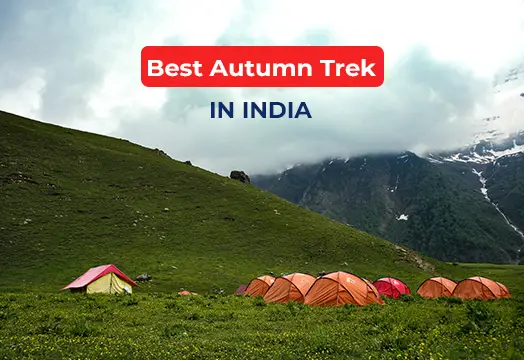
Region
Kathmandu | Nepal

Duration
13 Days

Max Altitude
18200 Ft.

Trekking Km
112 KM

Grade
Difficult
Get in Touch with Our Trek Expert
91 7351523841 info@trekthehimalayas.com10:00 hrs to 18:00 hrs | GMT +5:30
Monday - Saturday | Sunday Closed
67000 /Person
- March-2025
- April-2025
- May-2025
- October-2025
- November-2025
- USD 1500 +5% GST for Non-Indians and OCI card holders
- 5% GST will be applicable on Trek Cost and Add-ons
- Services from Kathmandu to Kathmandu.
- Lukla flight & Stay in Kathmandu included.
Add-ons
Offload 5300
- Backpack offload is optional.
- Choose add-ons during booking. If missed, log in and add them later.
- Book off-load at least 10 days before the trek.
- For offline bookings at the base camp, a convenience fee of Rs. 6500 applies.
- Cancellations made before the trip date will receive a full refund.
For more information. Please complete this form.
Get in Touch with Our Trek Expert
91 7351523841info@trekthehimalayas.com 10:00 hrs to 18:00 hrs | GMT +5:30
Monday - Saturday | Sunday Closed
Overview
Trek Name: Everest Base Camp Trek
Days: 13
Adventure Type: Trekking
Base Camp: Kathmandu
Season:Summer | Autumn |
Month:March | April | May | September | October | November |
Country: Nepal
Altitude: 18200 Ft.
Grade: Difficult
Rail Head: Kathmandu is not connected to any Railways
Stay: Hotel and teahouse
Food: Meals while on trek & at Hotel/Guesthouse (Veg & Eggs)
Location: Kathmandu
Distance: 112 Km.
Trail Type: Circle trail | Camping in various locations, starting and ending at the same point.
AirPort: Kathmandu (Tribhuvan International Airport)
Highlights:
- USD 1500 +5% GST for Non-Indians and OCI card holders
- 5% GST will be applicable on Trek Cost and Add-ons
- Services from Kathmandu to Kathmandu.
- Lukla flight & Stay in Kathmandu included.
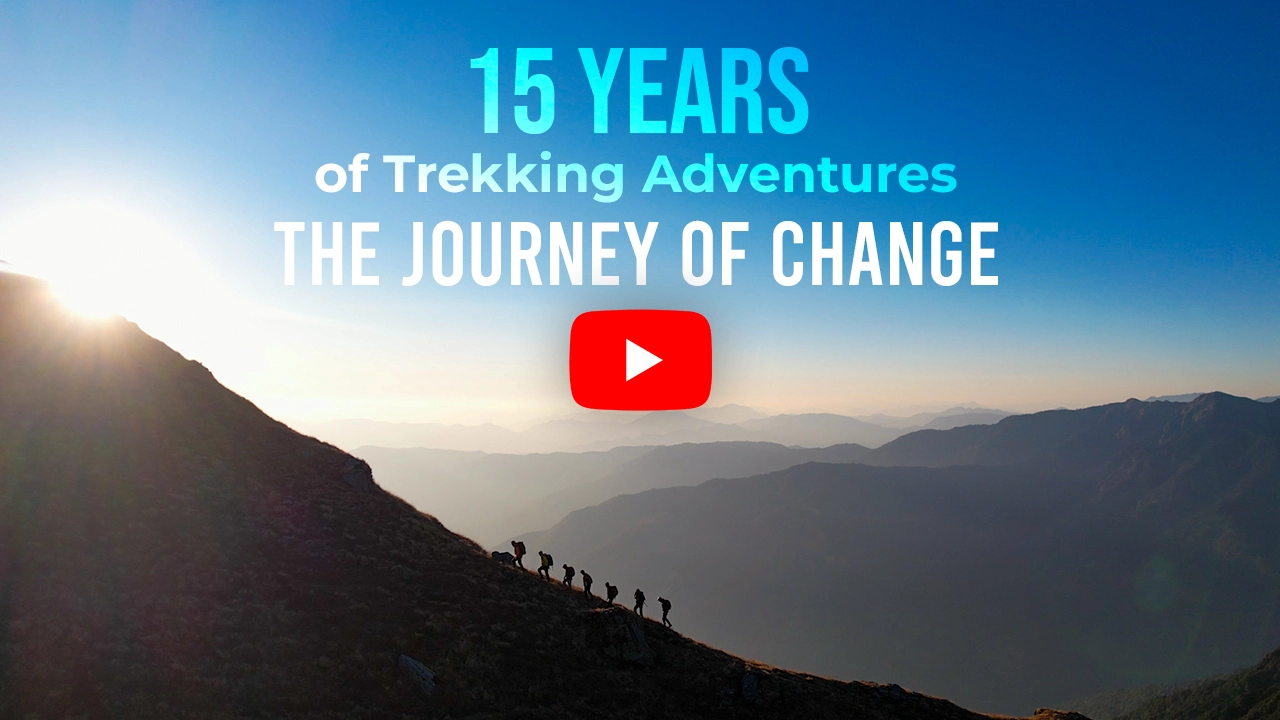
Why is Everest Base Camp Trek a Must-Do?
- Everest Base Camp Trek takes you closer to Mount Everest and offers you an exceptional view of the tallest peak on Earth.
- Along with Mount Everest, you also get a magnificent view of another 3 of the six highest peaks in the world, including Mt. Makalu, Mt. Lhotse, and Mt. Cho Oyu. Apart from these, you get a magnificent view of peaks like Ama Dablam, Nuptse, Kangtega, Pumori, Thamserku, and many more.
- With each step on the trail, you get to experience the beauty of Trekking in Nepal, with unmatchable views of towering snow-capped peaks, deep valleys, and glacial rivers.
- The trek trails pass through Sherpa villages, where you get insights into the rich culture and traditions of the mountain community.
- Trek to EBC is not just about the destination, it's more about the experience during the trek. Trekking at an altitude of over 5,000 meters is not an ordinary experience, the sense of accomplishment as you reach EBC can never be described in words.
- The stunning views throughout the trek will be your motivation to keep trekking. You will get magnificent views of glacial lakes and grand mountains and you will also spot Mt. Everest multiple times.
.webp)
Who Can Participate
- Age Requirement:
- Minimum 16 years
- First-timers are welcome, though prior trekking experience is preferred. Good fitness is a must.
- Fitness Criteria:
- If the trekker wants to carry a backpack then he/she should be able to carry a 10-12 kg backpack. If opt Off-load option then the Trekker should be able to carry 3-5 kg backpack.
- If a trekker's BMI is more or less than the normal range (18-26), please consult our Trek Coordinator before booking.
Everest Base Camp Trek Itinerary
Arrive At Kathmandu
- Altitude Kathmandu: 1,300 m/ 4,300 ft.
- Accommodation: Hotel
Welcome to trekkers’ paradise, Nepal. Nepal is characterized by beautiful Himalayan summits, rich natural biodiversity, and beautiful culture and history. Once you arrive at Kathmandu airport, we will pick you up and drive you to the booked hotel in Kathmandu. There are loads of taxis available at the airport and you can easily find one to drop you off at the hotel. Once you check in to the hotel, you can freshen up, and in the evening, you will receive a briefing session where you will learn about the trek and your schedule for the upcoming days. If you have any questions about the trek, then you can clear them at the time of the briefing session. Post the briefing session, you can explore Kathmandu and do some last-minute gear and equipment shopping if you want.
Important Note:
Due to heavy traffic at Kathmandu's Tribhuvan International Airport, most flights to Lukla have been diverted to Ramechhap airport (Manthali), which is an approximately 5-hour drive from Kathmandu. Your flight to Lukla will be booked for the next day. Make sure to rest early tonight, as you will need to leave Kathmandu by 2:00 AM to catch the early morning flight from Ramechhap the following day.
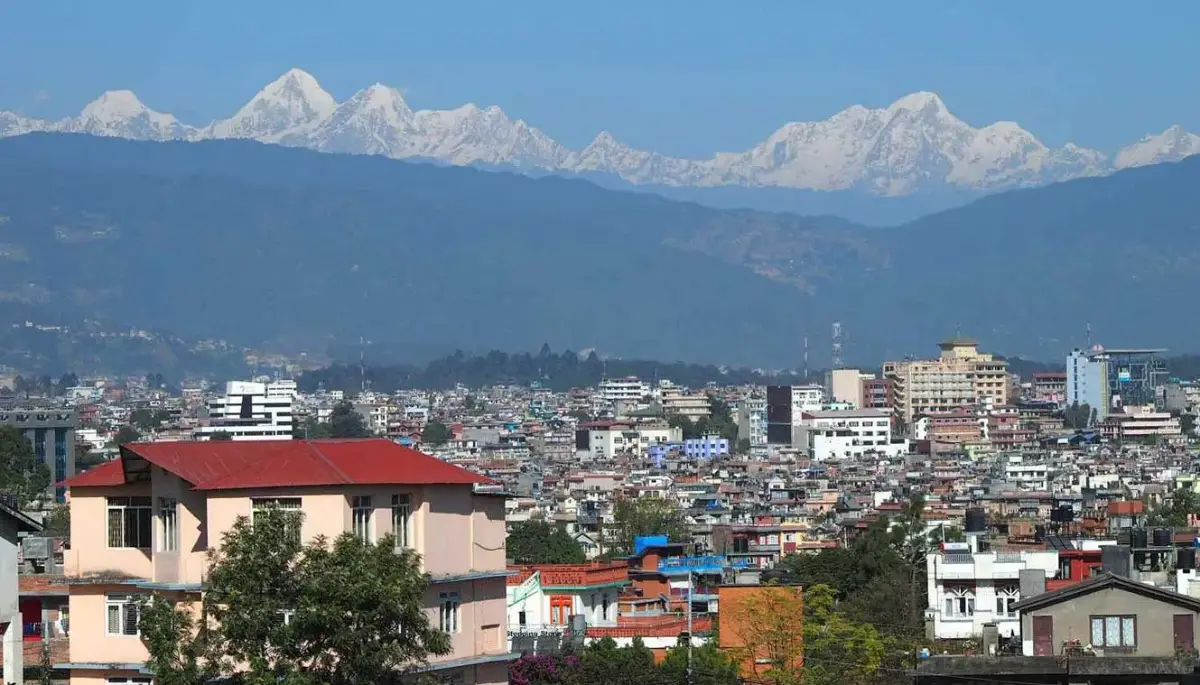
Drive from Kathmandu to Ramechaap then Fly to Lukla and Trek To Phakding
- Altitude
- Lukla: 2,800 m/ 9,200 ft.
- Phakding: 2,600 m/ 8,500 ft.
- Trek Distance (Lukla to Phakding): 7 km | 4-5 hrs.
- Accommodation: Teahouse
The day begins early as you depart Kathmandu at around 2:00 AM for the approximately 5-hour drive to Ramechhap Airport, where you’ll board your flight to Lukla. This short 30-minute flight shows the best aerial views of the Himalayan landscape, and makes it an exciting start to your trek.
The trail starts with a gradual descent, winding through picturesque Nepali mountain villages, lush forests, and crossing several suspension bridges. While you trek, you'll pass through Cheplung village, where you’ll catch a glimpse of the majestic Mt. Khumbila. Continuing on, you'll encounter beautiful boulders carved with Buddhist prayers, adding a cultural touch to the journey. The trek is easy, with a few gentle climbs and descents along the way. You’ll pass by the village of Ghat, before reaching Phakding.
Throughout the trek, you will enjoy beautiful views of the surrounding green mountains and the opportunity to buy or refill water bottles from local teahouses along the way. Phakding serves as an ideal stop for acclimatization and easing into the rhythm of the trek. The rest here will help prepare your body for the altitude changes ahead. Arriving at Phakding, you can settle, enjoy a warm meal, and relax. This initial hike serves as a perfect acclimatization step, preparing you for the exciting journey ahead through the majestic Everest region.
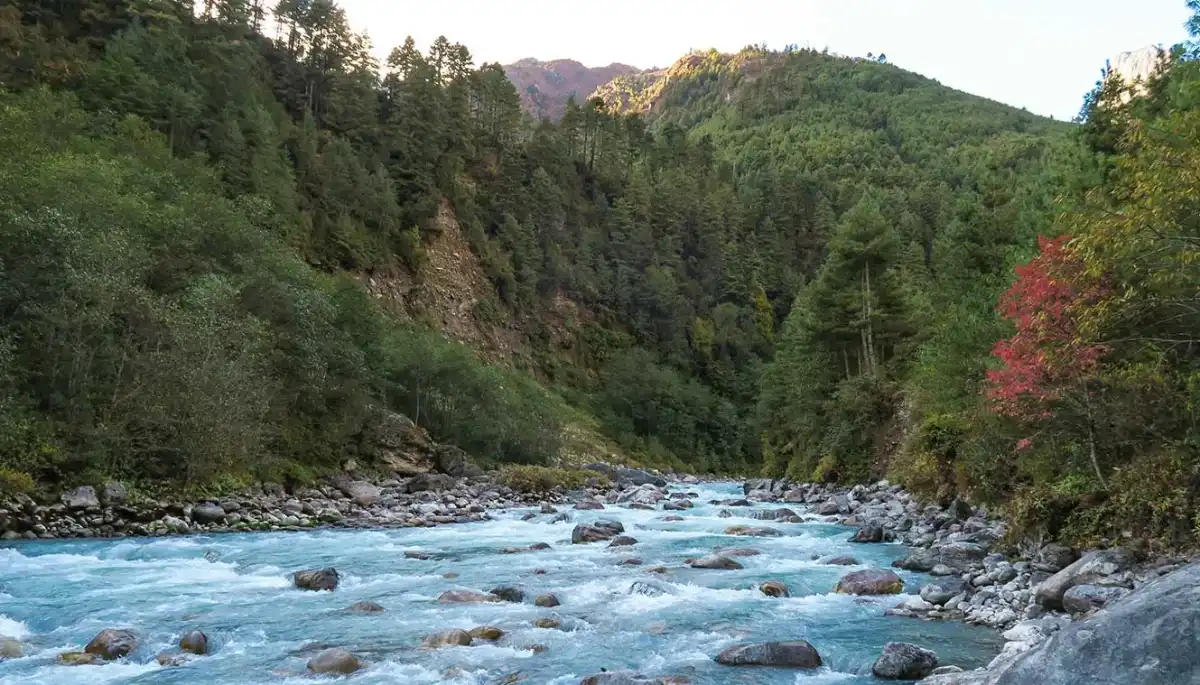
Trek from Phakding To Namche Bazaar | A Major Trading Hub In Khumbu
- Altitude:
- Phakding - 2,600 m / 8,500 ft.
- Namche Bazaar - 3,500 m / 11,500 ft.
- Trek Distance: 10 km | 7 hrs.
- Accommodation: Teahouse
Post breakfast, you will start your trek toward Namche Bazaar, the capital of the Khumbu region. The route today is surrounded by green mountains and will take you through suspension bridges over the Dudh Koshi and Bhote Koshi rivers. The Dudh Koshi River is often considered the lifeline of the Khumbu region, and will accompany us for much of today’s journey. Before entering the Sagarmatha National Park, you will have to obtain permits and then the trail follows a steep ascent before arriving at Namche Bazaar. Namche Bazaar is an important trading hub of the Khumbu region.
You will start your trek early in the morning from Phakding and soon you will cross a suspension bridge over the Dudh Koshi River. The walk from here is easy and pleasant with short uphill and downhill climbs. The Swiss suspension bridge on the Dudh Koshi River is a major attraction and a highlight of the trek. As you continue, you will encounter the second suspension bridge over the Bhote Koshi River, a bustling area filled with trekkers and porters. A moderate climb from this point leads to Monjo, which serves as the mid-point of the trek and a popular rest stop. Monjo is situated beneath the majestic Thamserku Peak and provides a glimpse of local Sherpa life, including traditional watermills used to grind barley, a staple in their diet Hillary Bridge that is photogenic. Along the way, you will also cross the Hillary Suspension Bridge, a photogenic spot often featured in pictures of the Everest trek. Afterward, a steep ascent takes you to the Everest Mid-Point, where glimpses of Mount Everest are visible on a clear day.
Treading along the Dudh Koshi River, you will arrive at the Sagarmatha National Park. At this point, your trekking permit will be checked and the officials will keep a record of all the trekkers going ahead. Sagarmatha is a UNESCO World Heritage Site that showcases stunning mountain views and rich biodiversity. Here, you may spot rare Himalayan species like snow leopards and the lesser panda. The presence of Sherpa settlements with their unique culture makes the trek even more interesting. A gradual walk from Sagarmatha National Park will lead you to Namche Bazaar. From Namche Bazaar, you will catch the first glimpses of Mt. Everest. Namche Bazaar is a historic trading center of the Khumbu area. At night you will stay here at a teahouse.
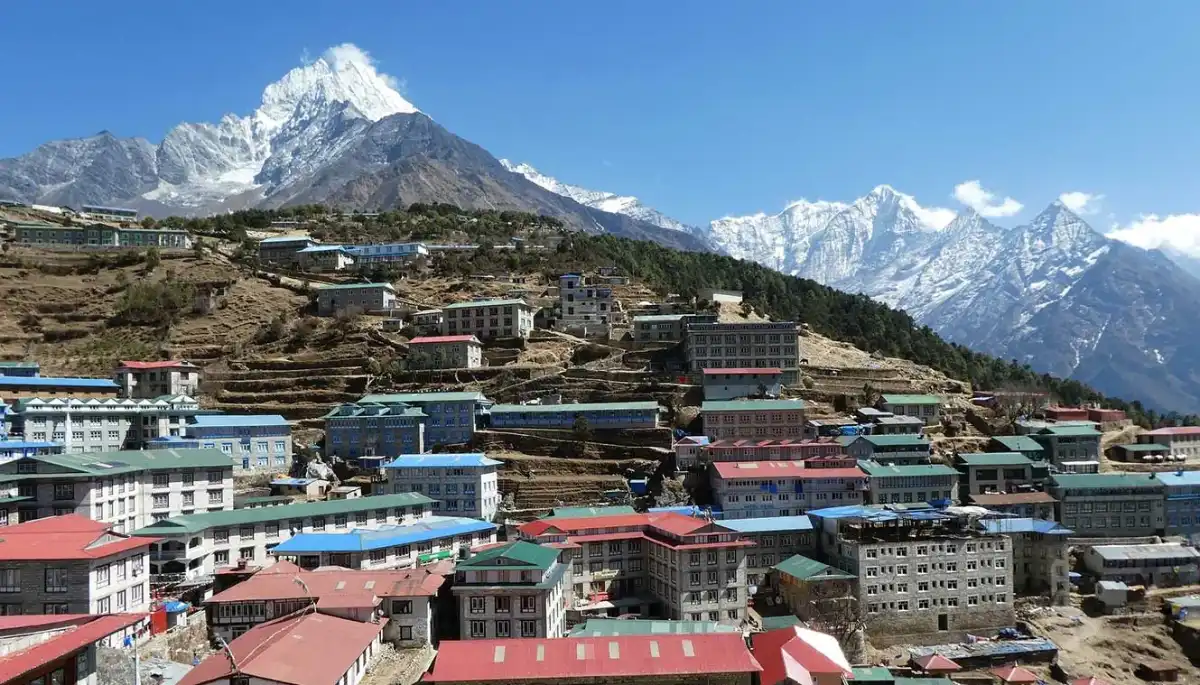
Acclimatization Day | Explore Namche Bazaar
- Accommodation: Teahouse
Wake up to the beautiful views of the highest Himalayan peaks and enjoy a delicious breakfast. Today you will stay in Namche Bazaar allowing your bodies to acclimatize to high altitudes. You can spend the day exploring the surroundings and enjoy the culture and hospitality of Nepal. Namche Bazaar is a commercial hub so you can do any last-minute trek shopping from here. The market has a vibrant atmosphere and there are a couple of restaurants and coffee shops as well.
You can do a short hike to Sagarmatha National Park headquarters. From here, you can get a good view of Ama Dablam, Mt. Everest, and other Khumbu peaks. Sagarmatha Museum is close by and lies just above Namche Bazaar. The museum gives you a fair amount of details about the history of the Himalayas, the geographic and cultural aspects, mountaineering history, and information about the various flora and fauna in the region. You will see many pictures of Tenzing Norgay and Edmund Hillary from their climb and maps detailing their trails as well.
You will also hike to Hotel Everest View, where you can catch a glimpse of Mt. Everest, Ama Dablam, and other Khumbu peaks.In the evening, take acclimatization walks around the market, preparing your body for higher altitudes. Soak in the Nepalese Buddhist culture, food, and traditions. Namche Bazaar gained popularity during the time when Tibetan salt was traded for grains from Nepal's lowlands. Nowadays, you can see a roaring trade of rugs, clothing, dried meat, and salt in the village center. There are many shops that also offer locally made handicraft items, you can buy them as souvenirs or gifts for your friends and families. You will stay the night at a teahouse in Namche Bazaar.
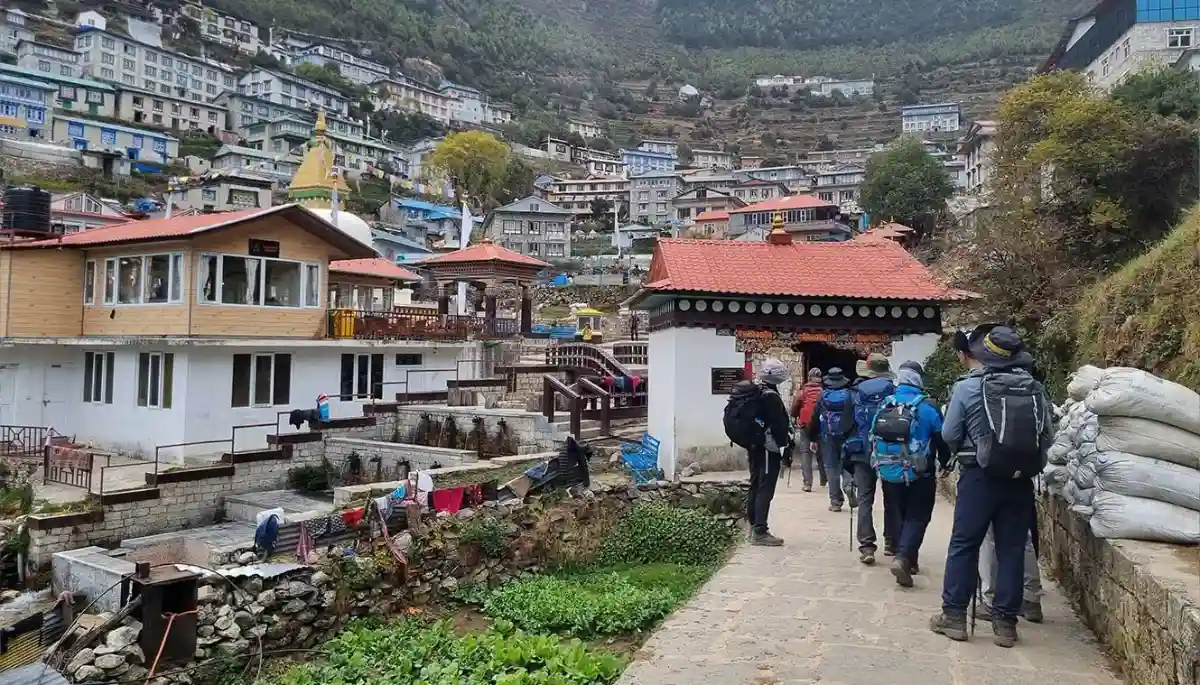
Trek from Namche Bazaar To Tengboche | Visit The Largest Buddhist Monastery Of Khumbu
- Altitude:
- Namche Bazaar - 3,500 m / 11,500 ft.
- Tengboche - 3,900 m / 12,700 ft.
- Trek Distance: 11 km | 5-6 hrs.
- Accommodation: Teahouse
Start your day with a delicious breakfast and get ready for your trek to Tengboche from Namche Bazaar. It’s a long trail and is a fairly easy trek accompanied by the views of the majestic Himalayas. You will also spot Himalayan Wildlife on the way as well. Tengboche is a small alpine valley that is situated at an altitude of 3860 m and the trek starts with an easy walk. The trek from Namche Bazaar to Tengboche is extremely beautiful and along your trek, you will get a bird’s eye view of Dudh Koshi River down below and the epic mountain views as Thamserku, Kantega, Ama Dablam, Lhotse and Everest comes into view.
The trek begins with a walk to the top of Namche Bazaar, where the trail descends to Khumjung, Sherpa village and then climbs up the sides of the mountains through some stairs and then diverges from the Everest Highway at Sanasa. You will be able to catch glimpses of Lhotse, Nuptse, and Mt. Everest from here. This is probably the best view of Mt. Everest you will get until you reach Gorakshep when climbing to Kala Patthar. Two hours of pleasant walking will bring you to Sanasa. Up to Sanasa, it is a walk-through forest covered with Oak and Rhododendrons. It is a great location for bird watching and you may spot the Danphe Pheasant, the national bird of Nepal. Musk-deer and Himalayan Tahr, a Himalayan goat that looks like an antelope are commonly spotted in these areas. You will also spot the Tengboche monastery from here which you will reach in the later part of your trek.
Next, following a gradual descent, you will reach the Imajtse River at Phunki Tenga at an altitude of 3,250 meters. Phunki Tenga is a small Himalayan settlement with teahouses and army posts. The climb down can be a little tougher as the terrain is rocky and uneven. You will reach a suspension bridge over the river and after you make the crossing, you will need to get permits at a checkpoint to proceed further in your trek. From here it is a strenuous climb of about an hour that will take you to a Tengboche village where you can see the Buddhist monastery. This is the last part of today’s trek and you can expect the trail to be rocky with a couple of switchbacks. Don’t push yourself too hard, take it slow and steady as you make your trek uphill.
Tengboche Monastery, locally known as Dawa Choling Gompa is the largest monastery in the Khumbu region. It overlooks the beautiful region and the mountain landscapes around it. There are daily prayers that occur in the morning and evening. You can take part in the prayers if you truly want a cultural experience. It is one of the important cultural aspects of the EBC Trek. Enjoy the serenity at this revered place of worship and night your stay will be in the teahouse at Tengboche.
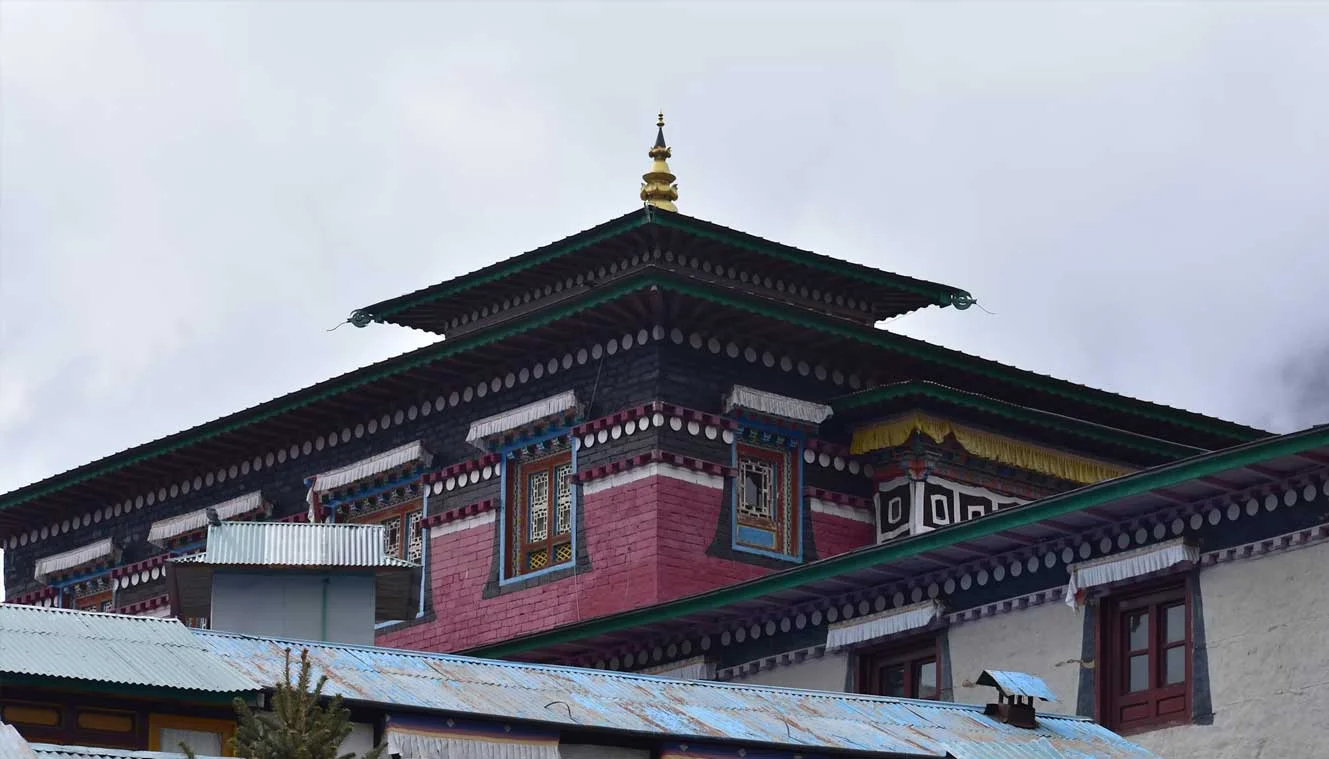
Trek from Tengboche To Dingboche | Stunning Views Of Ama Dablam
- Altitude:
- Tengboche - 3,900 m / 12,700 ft.
- Dingboche - 4,300 m / 14,200 ft.
- Trek Distance: 12 km | 6-7 hrs.
- Accommodation: Teahouse
Today, you will begin your trek towards Dingboche. From Tengboche, cross bridges and rivers accompanied by beautiful mountain views to Dingboche. Stone steps will lead you through forests of Rhododendrons, conifers, and birches, and at the bottom of the forest lies the Deboche village. From here, the trail rises and enters into the alpine meadows and Dingboche. Dingboche is the only place in the entire Khumbu region where barley is grown. The views of the Himalayas are amazing from Dingboche. Start your trek from Tengboche and walk towards Pangboche Village, you will get to see some beautiful views of Mt. Ama Dablam and from Pangboche you will trek towards Pheriche and to Imja Valley. The beautiful Lobuche River passes through Imja Valley and from here a steep hike will take you to Dingboche.
At the beginning of the trail, you will first descend into a forest trail passing the small settlement of Deboche. As you trek from Tengboche to Dingboche, the scenery changes as you gain altitude, greenery slowly giving way to barren landscapes, and the trails gradually becoming more rugged and it will also start getting cold and windy. In the initial part of the trek, you will pass by a wall with stone inscriptions and a small stream will keep you company along the trail. You will have to cross the stream to the left-hand side of the valley. The majestic Ama Dablam dominates the skyline ahead of you. About two hours into the trek, you will arrive at Pangboche, a mountain village, where you get beautiful views of Mt. Everest. From Pangboche, you will hike upwards towards the valley, and throughout the trek, you will slowly gain elevation. Although the trek is mostly uphill, the slope is relatively easy without extremely steep inclines. Ama Dablam continues to stay in view, however, you will only get to see a tiny sliver of the top of Mt. Everest. Lhotse and Nuptse become quite prominent now.
Soon you will arrive at the village of Shomare, your last village before Dingboche. Ama Dablam remains in view but now you will get to see a different angle of the mountain from what you have seen before. The trail continues winding to the valley side and you will cross another river before entering Dingboche village. Dingboche is a lovely Himalayan hamlet and you will see agricultural fields protected by stone walls. Once at the village, you will stay the night in the teahouse.
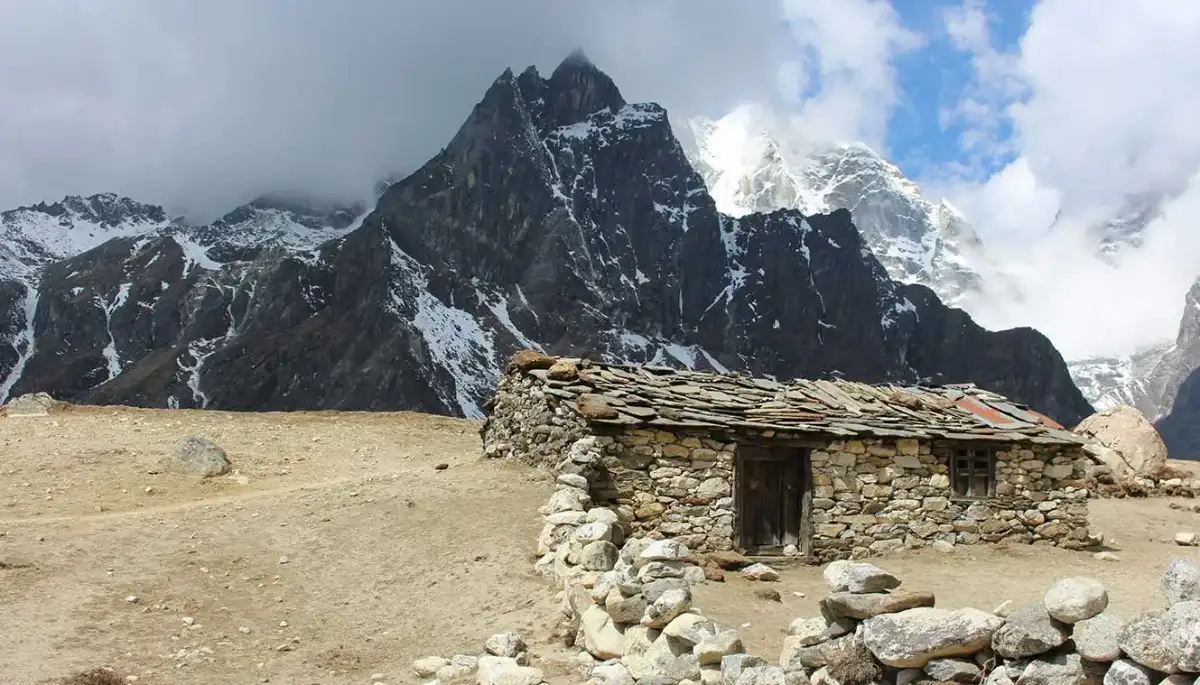
Dingboche (Rest Day) | Acclimatize To Higher Altitudes
- Accommodation: Teahouse
Today is a rest day at Dingboche, which will help us acclimatize to the high altitude. As you exert a good deal of energy on the trek, your body needs to get accustomed to less oxygen at higher elevations. So instead of taking a rest day, if you continue to gain elevation it can result in altitude sicknesses like dizziness, nausea, and headache or potentially even more dangerous conditions like cerebral or pulmonary edema. To prevent these issues, you start your acclimatization process.
To acclimatize well, take short walks and follow the “climb high, sleep low” method. This means you should hike to a higher altitude during the day and return to a lower altitude to sleep. A great way to do this is by hiking to nearby spots and view points. The gradual ascent helps your body adjust to the thinning air, reducing the risk of altitude sickness.
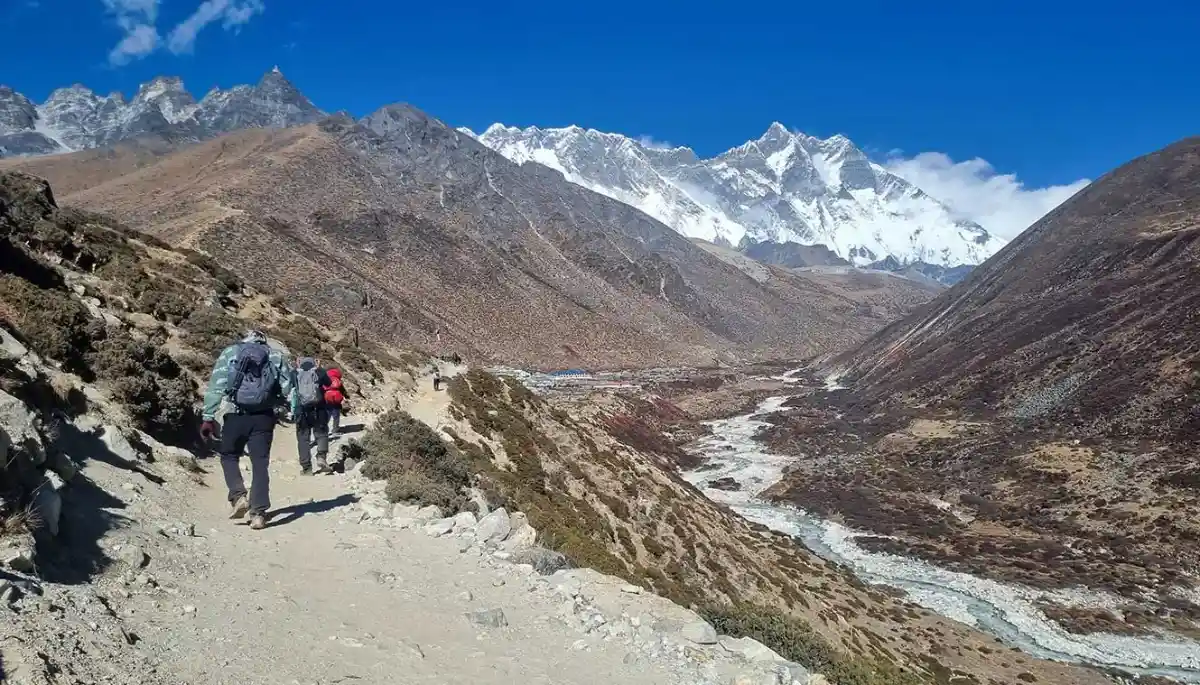
Trek from Dingboche To Lobuche | Pay Your Respects In Everest Memorial
- Altitude:
- Dingboche - 4,300 m / 14,200 ft.
- Lobuche - 4,900 m / 16,200 ft.
- Trek Distance: 6 km | 4-5 hrs.
- Accommodation: Teahouse
Today’s trek takes you deeper into the rugged beauty of the Khumbu region as you ascend from Dingboche to Lobuche. This day marks a significant step in your journey toward Everest Base Camp. Start your day early with breakfast at Dingboche, where you can catch the morning light reflecting on the surrounding peaks. The trail begins with a gentle incline along the valley, running parallel to the mountain’s wall. You’ll pass through alpine pastures, where yaks can often be seen grazing during the summer months. When you leave Dingboche, you’ll ascend a small ridge behind the village. To the north, the majestic Lobuche Peak and the glistening snowfields of Cho La dominate the landscape, setting the tone for the incredible views ahead.
A short descent brings you to the village of Pheriche, where you'll notice a calm stillness in the air. This village is often used as a resting point on the return journey from Everest Base Camp. For now, it serves as a beautiful spot along the way. The trail becomes more challenging as you head toward Thukla, a small settlement at the base of the Thukla Pass. The climb to Thukla Pass is one of the most demanding parts of the trek, involving a steep and zig-zagging ascent along a rocky moraine stone cairns and fluttering prayer flags.
These shrines commemorate climbers and Sherpas who lost their lives on Everest, offering a poignant moment of reflection amidst the peaks. Take a moment to rest and soak in the powerful atmosphere of this place. From Thukla Pass, the trail flattens slightly as it winds along the edge of the Khumbu Glacier, a vast, icy expanse that flows from Everest. As you follow the glacier, you will see the views of Mt. Nuptse, which looms majestically in the distance. The landscape here begins to feel otherworldly, with its barren, rocky terrain contrasting against the snowy peaks.
The final stretch to Lobuche involves a gradual incline, and the altitude becomes more noticeable, so take it slow and steady. On arrival at Lobuche, you’ll settle into a teahouse for the night. Lobuche is a small, remote village with only a handful of accommodations, but its charm lies in its simplicity and the breathtaking views that surround it. In front of you, you get to see a beautiful view of Nuptse.Lobuche is a small Himalayan village with just a handful of teahouses, and provides a cozy retreat for the night. You will rest here before heading to the final village on your trek tomorrow.
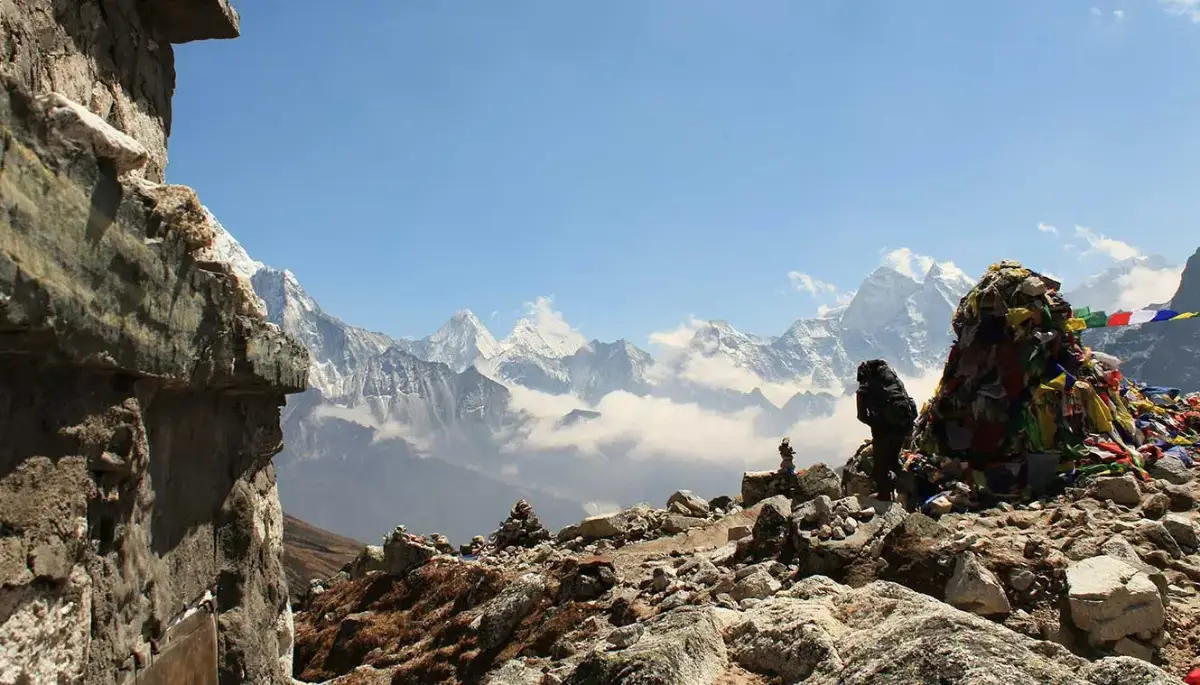
Trek from Lobuche To Gorakshep | Excursion To Everest Base Camp
- Altitude:
- Gorakshep - 5,200 m / 17,000 ft
- Everest Base Camp - 5,400 m / 17,700 ft
- Trek Distance:
- Lobuche To Gorakshep: 6 km | 3-4 hrs.
- Gorakshep To EBC: 3 km away each | 2hrs.
- Accommodation: Teahouse
Note: Drinking water in Gorakshep is chargeable. We don’t include drinking water on the trek which you can buy from a number of places between $1 to $3 a bottle (it gets more expensive towards the base camp). The better alternative is to buy water tablets in Kathmandu/Pokhara for around $2 and treat the water.
Today is the most exciting day of the trek as you make an excursion to the Everest Base Camp. An adventurous journey and a great trekking experience await you. Today's trek is broken down into two parts, the first part is the trek from Lobuche to Gorakshep and the second part is an excursion to EBC and back to Gorakshep. Wake up early, have your breakfast, and gear yourself up.
After breakfast at Lobuche campsite, you began your trek towards Gorakshep. Walking along the sandy and rocky parts, you will gradually gain elevation as you walk alongside the Khumbu Glacier. The last section of the trail directs into a glacier before you reach Gorak Shep. The terrain is rocky and uneven with inclines and declines. Be cautious and watch your step in this part and always pay heed to the trek leader's advice to complete the patch safely. As you reach Gorakshep, it's important to note that drinking water here is chargeable, ranging from $4 to $5 a bottle, with prices increasing as you get closer to the base camp. To save costs and ensure clean water, you can buy water purification tablets in Kathmandu and treat the water yourself. Mt. Nuptse looms on the horizon in front of you. You can see a sliver of the top of Mt. Everest from here, right behind Nuptse. Soon the village of Gorak Shep comes into view guarded by Kala Patthar and Pumori in the back. Make your way into the guest house, have some lunch, reenergize yourself and get ready for the next part of the trek.
behind it. It is a vast glacier and as you continue walking along the side of the glacier, you will constantly gain elevation until you reach the base camp. The incline is not very steep and is slightly moderate. A technical terrain lies ahead of you with a mixture of sand and rocks and it can get pretty slippery at some points as well. Continue on and you will reach a point where the Khumbu icefall comes into better view as it winds down from the mountain to the valley. On the way, you will pass Sherpa flag monuments indicating that you are getting closer to the Everest Base Camp. In the final stretch of the trail, you will see numerous prayer flags flowing in the wind and the popular Everest Base Camp Rock. You have made it to the Base Camp, congratulations! While this is not the actual base camp, it is a trekker’s base camp. Most trekking groups are not allowed to enter or stay in EBC. Once you have had enough time to enjoy the area around EBC, it is time to head back to Gorakshep. Follow the rocky trail back to Gorak Shep. You will stay the night in Gorak Shep.
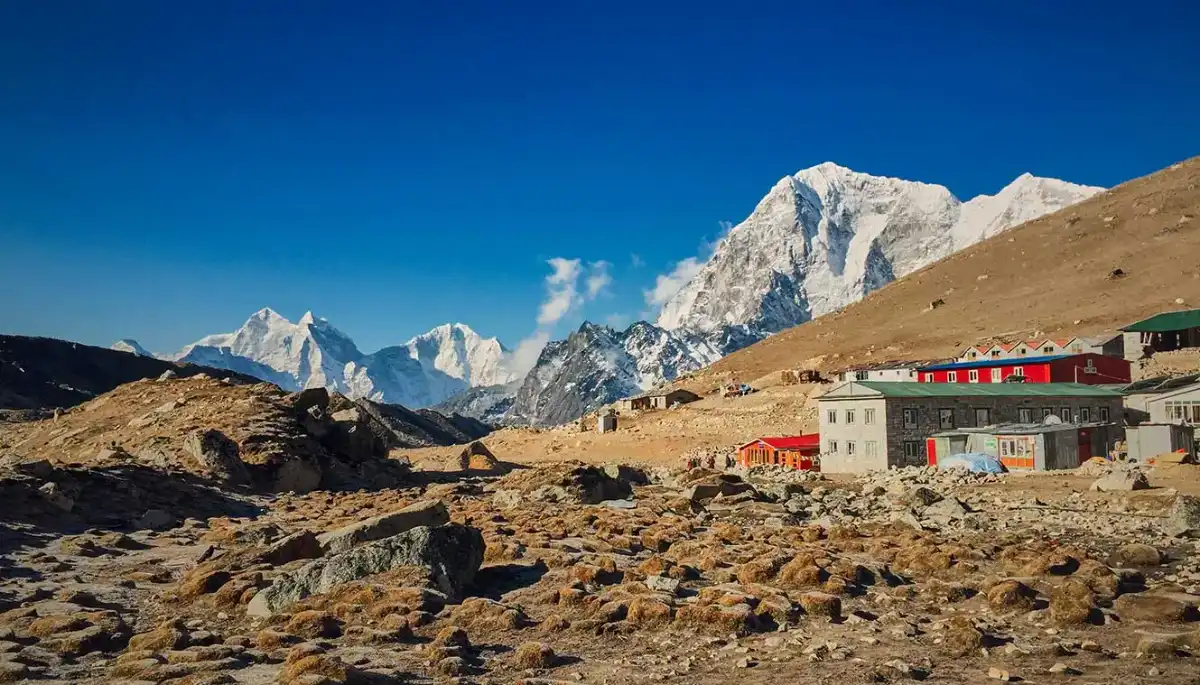
Hike To Kalapatthar And Retreat Trek To Pangboche | Enjoy Arresting Views Of Mt. Everest
- Altitude:
- Kalapatthar - 5,500 m / 18,200 ft.
- Pangboche - 3,900 m / 12,800 ft.
- Trek Distance:
- Gorakshep to Kalapatthar - 4 km Both way | 3-4 hrs.
- Gorakshep to Pangboche - 19 km | 7-8 hrs.
- Accommodation: Teahouse
After your trek to EBC and back to Gorakshep, you are now ready to climb Kala Patthar. The trek starts with an easy walk from Gorakshep and you will be walking on sandy fields. After this, there is a steep climb. After the strenuous climb, you will come to level fields and the walk is easy and gradual. You will have the comfort of walking for the next one hour, after which there is another steep climb to Kalapatthar for about half an hour. From this point Mt. Everest looks closer than you can imagine.
You will start your day early, leaving your belongings at Gorakshep and carrying only a daypack with essentials, as you will return to Gorakshep later. As you ascend, the peak of Mt. Everest gradually comes into view, rising above the surrounding mountain ranges. The higher you climb, the more prominent it becomes. However, as you gain altitude, the trail becomes increasingly rocky and challenging. Be cautious and watch your steps, especially on the final stretch, which is particularly rugged.
Once you reach Kala Patthar, you will witness one of the most beautiful sunrises, with the golden rays illuminating the peaks of Mt. Everest, Ama Dablam, and Mt. Nuptse. (Everest, South Col, Lhotse, Makalu, Khumbu Glacier & icefall, Pumori & Everest Base Camp.) After taking in the incredible views, you will return to Gorakshep to enjoy a hearty breakfast and recharge for the descent to Pangboche.
The journey back to Pangboche takes you through Lobuche, retracing your steps alongside the Khumbu Glacier. Having already covered this section on your ascent, you’ll have a better idea of what lies ahead. The trek can be slightly challenging until you reach the expansive Sagarmatha National Park, after which the trail becomes more manageable.
As you descend, you will come to the intersection where one path diverges towards Dzonghla village, Cho la pass, and Gyoko Ri, while the left trail heads towards Pangboche. Stay on the left side of the trail and you will come across another challenging patch of the trek. You will head down from the moraine wall of the Khumbu Glacier and descend to the Thukla Pass.
Pheriche lies just below Dingboche so after crossing Thukla, you can take the lower path towards Pheriche instead of taking the higher path towards Dingboche. Once you arrive at Pangboche, you will check into a teahouse, enjoy a warm meal, and get some well-deserved rest to prepare for your journey to Namche Bazaar the following day.
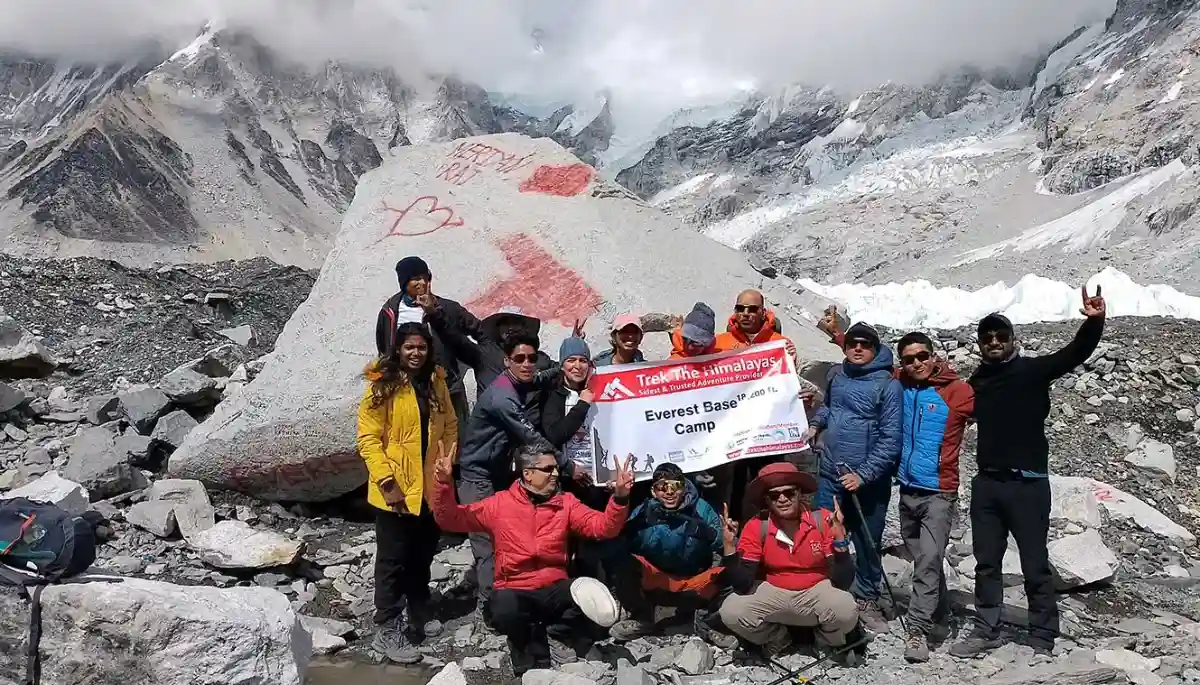
Trek from Pangboche To Namche Bazaar | Buy Some Souvenirs
- Altitude:
- Pangboche - 3,900 m / 12,800 ft.
- Namche Bazaar - 3,500 m / 11,500 ft.
- Trek Distance: 14 km | 6-7 hrs.
- Accommodation: Teahouse
Today you’ll begin your descent toward Namche Bazaar. After descending to Namche Bazaar, the most challenging part of your trek is behind you. The remaining descent promises to be easier, especially after conquering the Everest Base Camp trek. However, we recommend starting early, as the journey is long and will require steady effort. Begin your day by heading down to the village, crossing the river, and climbing back up the valley wall. This initial incline is a great spot to pause, catch your breath, and enjoy the surroundings before continuing your descent.
Once you descend further, you will cross a suspension bridge and encounter a gradual 2 km incline along the valley wall. This section winds through a forested trail, offering refreshing views and shade as you zig-zag uphill. After completing this ascent, the remaining distance to Namche Bazaar is relatively smooth and enjoyable. As you approach Namche Bazaar, the atmosphere becomes livelier, with the bustling market town coming into view. After days of trekking through remote regions, returning to Namche feels like a warm welcome back to civilization. Check into your teahouse, enjoy a hot meal, and take the evening to relax.
Tonight, you’ll rest in Namche Bazaar. Rest well, as tomorrow marks the final day of your incredible journey through the Khumbu region.
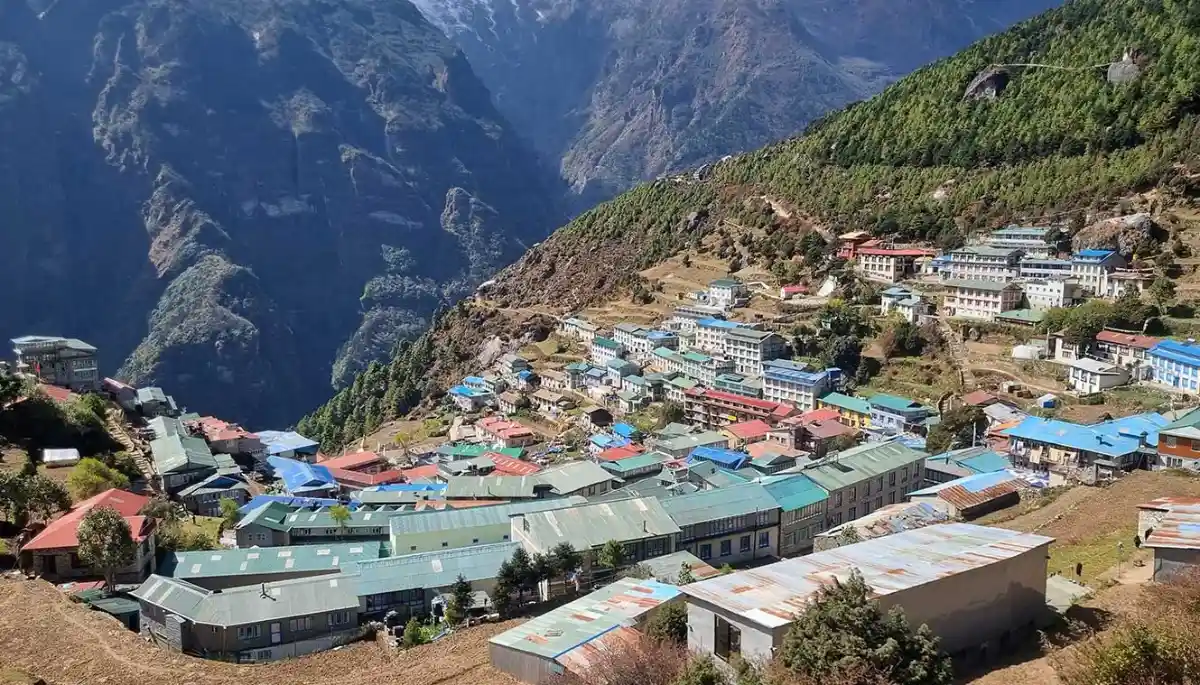
Trek from Namche Bazaar To Phakding To Lukla | Last Day Of Trekking
- Altitude:
- Namche Bazaar - 3,500 m / 11,500 ft.
- Phakding - 2,600 m / 8,500 ft.
- Lukla - 2,800 m / 9,200 ft.
- Trek Distance: 16 km | 7-8 hrs.
- Accommodation: Teahouse
Waking up to the lovely weather at Namche Bazaar, you can visit the place and roam around a little bit. You can explore the market and buy souvenirs from your trip to the Everest Base Camp and buy gifts for your friends and family. There are several local handicraft stores in Namche Bazaar as it is the biggest trade hub in the Khumbu region. You can also take a small walk-in around the Sagarmatha National Park and enjoy the local cuisine as well.
Right at the beginning of the trek, you will begin to lose elevation. After walking for some time, you will reach a rest stop. This is where you will get the last glimpses of Mt. Everest. After this point, there are no mountain views anymore, only little peeks from behind the forest covers. You will cross a few suspension bridges and continue alongside the river as the initial steep decline eases into a more moderate decline. While most of the trek is downhill, there are a few uphill climbs as well.
You will pass by Sherpa stones as you descend easily into the village of Phakding. It is an easy trek down to the village. The beauty of the distant mountains with several waterfalls adds to the beauty of your journey. This is the beauty of Nepal trekking, there will be a few uphill climbs but you will manage it very easily.
There will be a rest at Phakding for lunch before descending further down the valley with river views, mountain ridges, and suspension bridges. You will also have several stair sections and an incline path all the way through. Passing by a few more villages, you will arrive at Lukla, your final stop for the day.
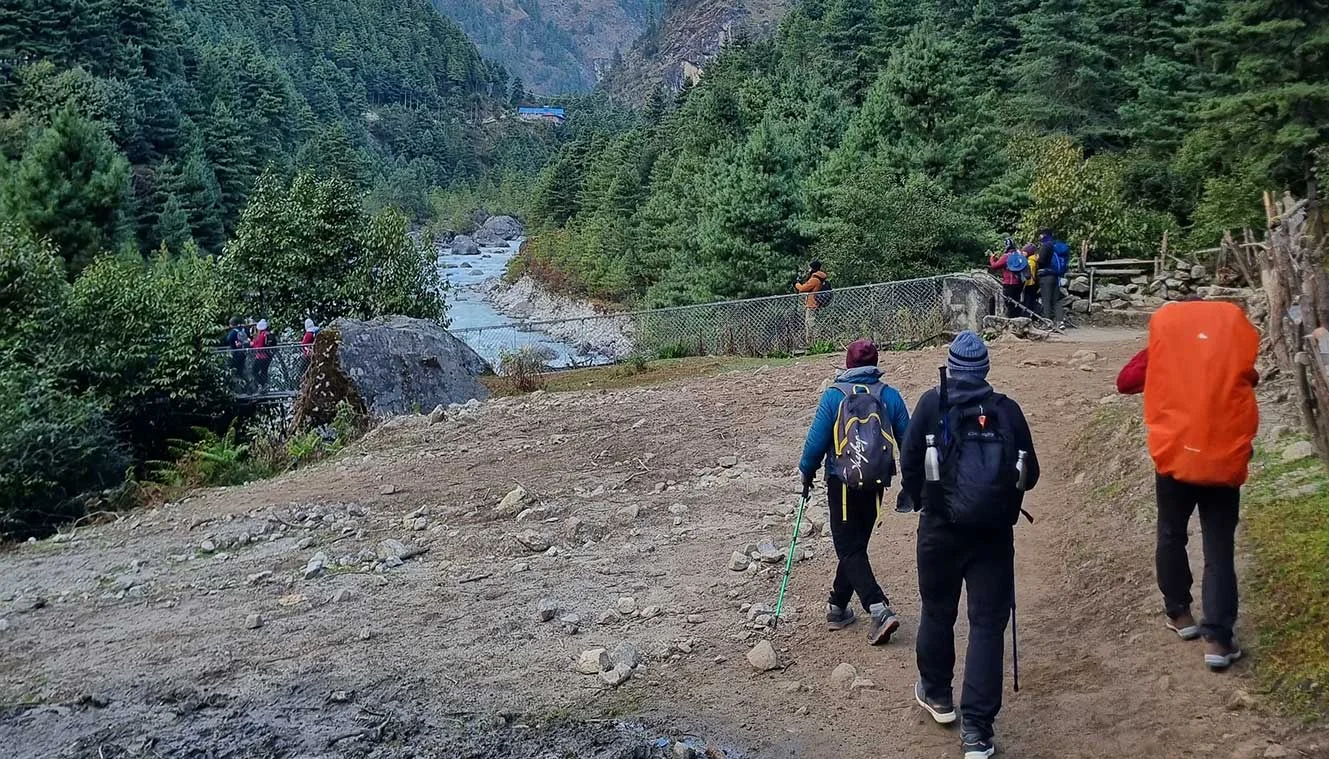
Flight from Lukla to Ramechhap and drive to Kathmandu
- Your trek to Everest Base Camp is over.
- Spend the day in Kathmandu or fly back to your onwards destination.
Note: Weather conditions may cause flight cancellations. Delays are
possible any time of the year but are more typical on summer departures. Keep 3-4 buffer days.
Today marks the end of your incredible trekking journey as you prepare to leave this beautiful Everest region. The day starts early, as flights from Lukla to Ramechhap are usually scheduled in the morning. Morning flights are generally more reliable; however, weather conditions may cause flight cancellations or delays. These delays can occur any time of the year but are more common during summer departures. It is recommended to keep 3-4 buffer days to account for such situations.
Once your flight takes off from Lukla, take one last look at the Himalayan peaks and lush valleys you’ve traversed. The aerial views from the plane are breathtaking and provide a unique perspective of the landscapes you’ve explored over the past days. After landing at Ramechhap Airport, you’ll drive back to Kathmandu. The drive through rural Nepal will offer a glimpse of life outside the city before you reach the hustle and bustle of Kathmandu. Hotel accommodation and dinner in Kathmandu is included in the cost, allowing you to spend the day in the city or prepare for your onward destination.
You can now plan and book your onward journey from Kathmandu. We hope the memories and experiences you’ve gained during this journey will stay with you for a lifetime.
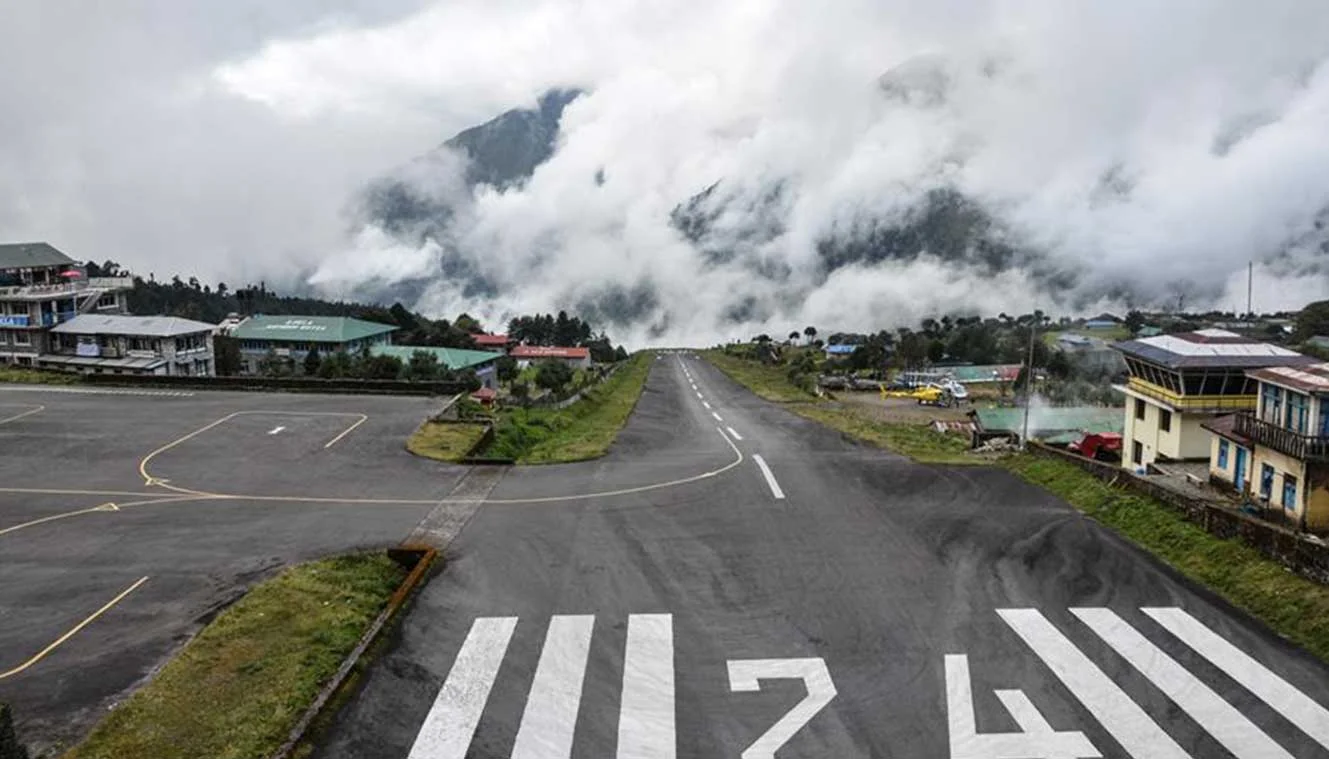
Day-1: Arrive At Kathmandu
- Altitude Kathmandu: 1,300 m/ 4,300 ft.
Day-2: Drive from Kathmandu to Ramechaap then Fly to Lukla and Trek To Phakding
- Altitude
- Lukla: 2,800 m/ 9,200 ft.
- Phakding: 2,600 m/ 8,500 ft.
- Trek Distance (Lukla to Phakding): 7 km | 4-5 hrs.
Note:
Flights to Lukla are prone to delay due to weather, keep 3-4 buffer days in your plan.
Day-3: Trek from Phakding To Namche Bazaar | A Major Trading Hub In Khumbu
- Altitude
- Phakding - 2,600 m / 8,500 ft.
- Namche Bazaar - 3,500 m / 11,500 ft.
- Trek Distance: 10 km | 7 hrs.
Day-4: Acclimatization Day | Explore Namche Bazaar
Day-5: Trek from Namche Bazaar To Tengboche | Visit The Largest Buddhist Monastery Of Khumbu
- Altitude:
- Namche Bazaar - 3,500 m / 11,500 ft.
- Tengboche - 3,900 m / 12,700 ft.
- Trek Distance: 11 km | 5-6 hrs.
Day-6: Trek from Tengboche To Dingboche | Stunning Views Of Ama Dablam
- Altitude:
- Tengboche - 3,900 m / 12,700 ft.
- Dingboche - 4,300 m / 14,200 ft.
- Trek Distance: 12 km | 6-7 hrs.
Day-7: Dingboche (Rest Day) | Acclimatize To Higher Altitudes
Day-8: Trek from Dingboche To Lobuche | Pay Your Respects In Everest Memorial
- Altitude:
- Dingboche - 4,300 m / 14,200 ft.
- Lobuche - 4,900 m / 16,200 ft.
- Trek Distance: 6 km | Duration: 4-5 hrs.
Day-9: Trek from Lobuche To Gorakshep | Excursion To Everest Base Camp
- Altitude:
- Gorakshep - 5,200 m / 17,000 ft
- Everest Base Camp - 5,400 m / 17,700 ft
- Trek Distance:
- Lobuche To Gorakshep:6 km | 3-4 hrs.
- Gorakshep To EBC: 3 km away each | 2hrs.
Day-10: Hike To Kalapatthar And Retreat Trek To Pangboche | Enjoy Arresting Views Of Mt. Everest
- Altitude:
- Kalapatthar - 5,500 m / 18,200 ft.
- Pangboche - 3,900 m / 12,800 ft.
- Trek Distance:
- Gorakshep to Kalapatthar - 4 km Both way | 3-4 hrs.
- Gorakshep to Pangboche - 19 km | 7-8 hrs.
Day-11: Trek from Pangboche To Namche Bazaar | Buy Some Souvenirs
- Altitude:
- Pangboche - 3,900 m / 12,800 ft.
- Namche Bazaar - 3,500 m / 11,500 ft.
- Trek Distance: 14 km | 6-7 hrs.
Day-12: Trek from Namche Bazaar To Phakding To Lukla | Last Day Of Trekking
- Altitude:
- Namche Bazaar - 3,500 m / 11,500 ft.
- Phakding - 2,600 m / 8,500 ft.
- Lukla - 2,800 m / 9,200 ft.
- Trek Distance: 16 km | 7-8 hrs.
Day-13: Flight from Lukla to Ramechhap and drive to Kathmandu
- Your trek to Everest Base Camp is over.
Note: Weather conditions may cause flight cancellations. Delays are possible any time of the year but are more typical on summer departures. Keep 3-4 buffer days .
Everest Base Camp Trek Graph
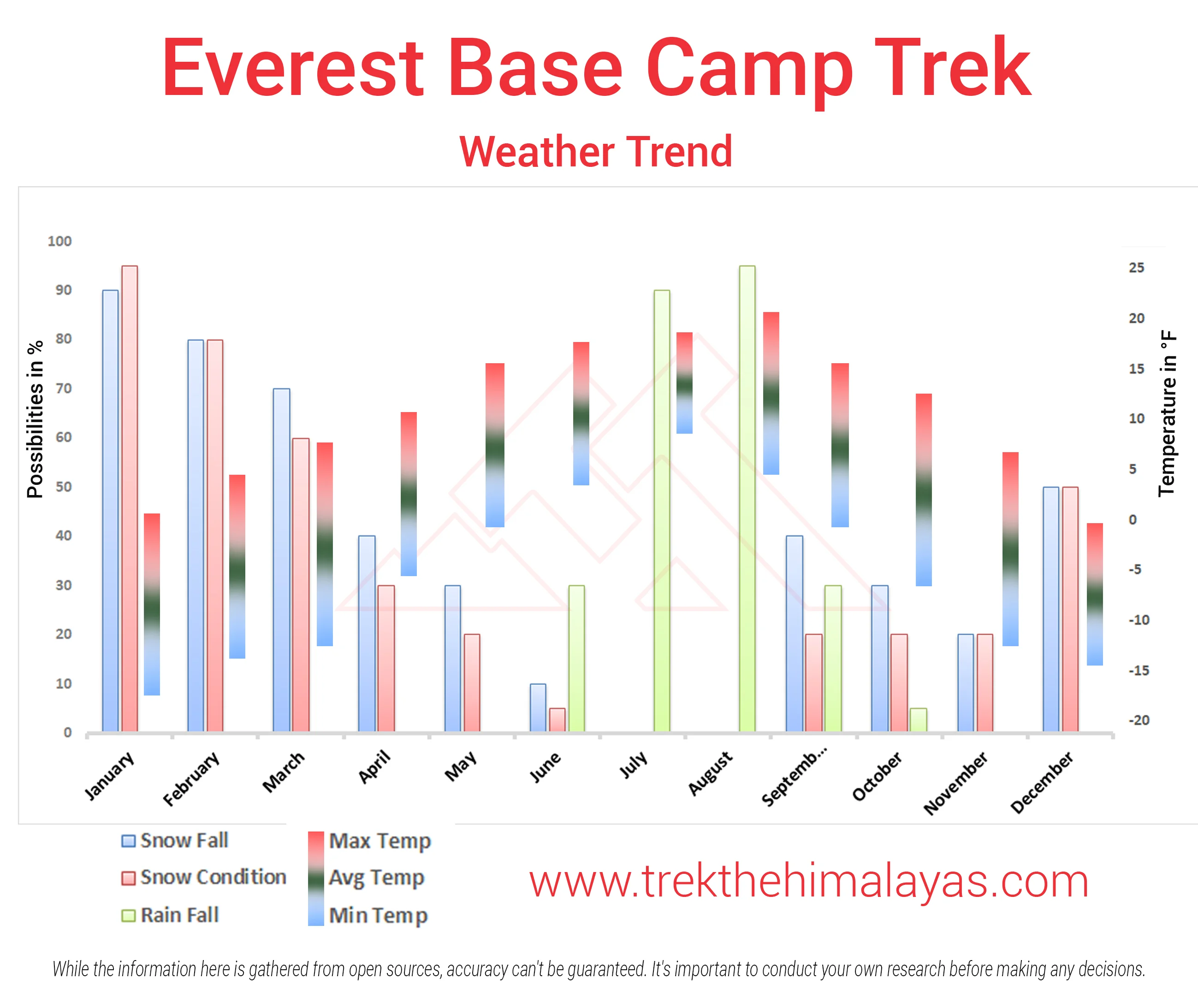
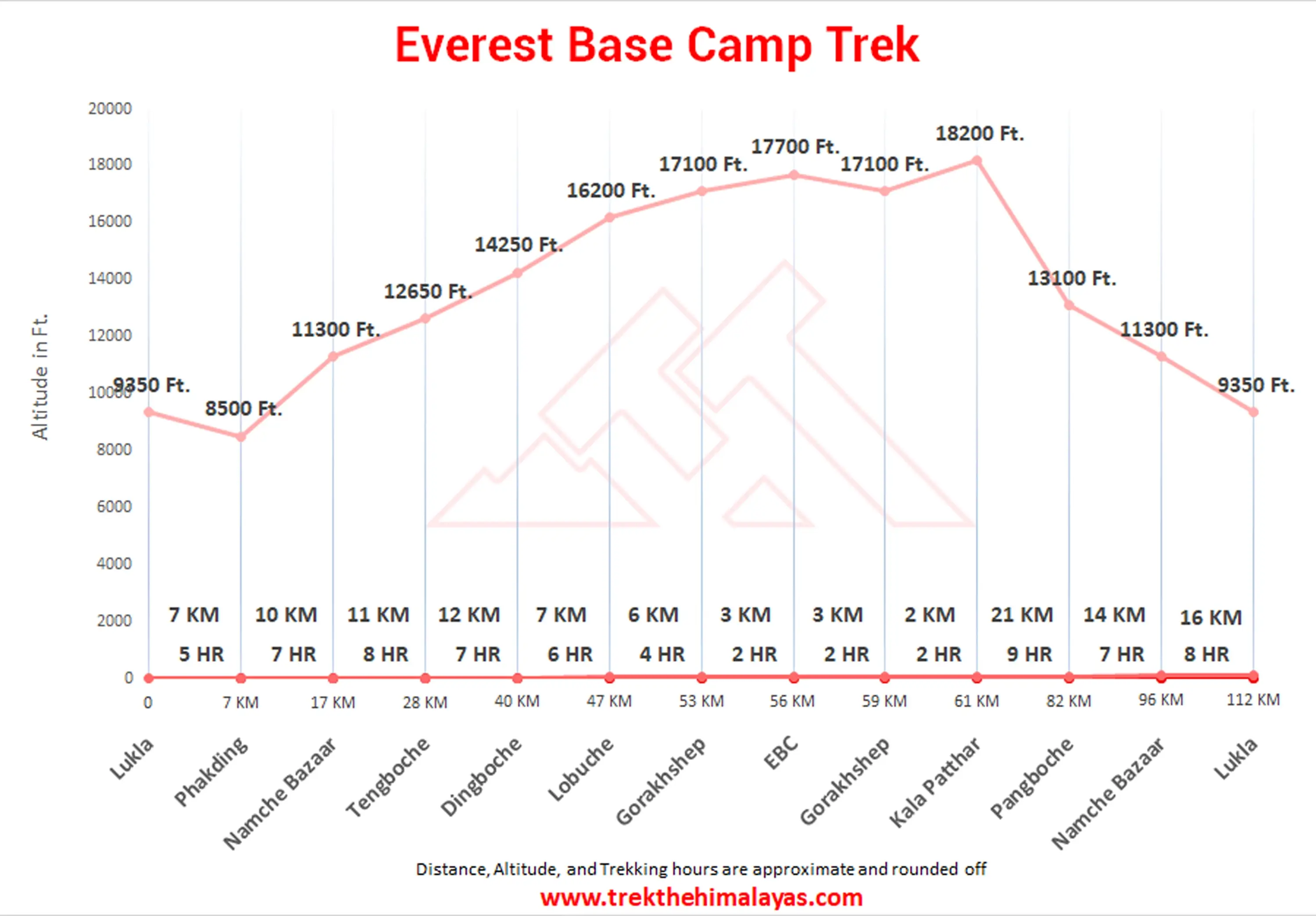
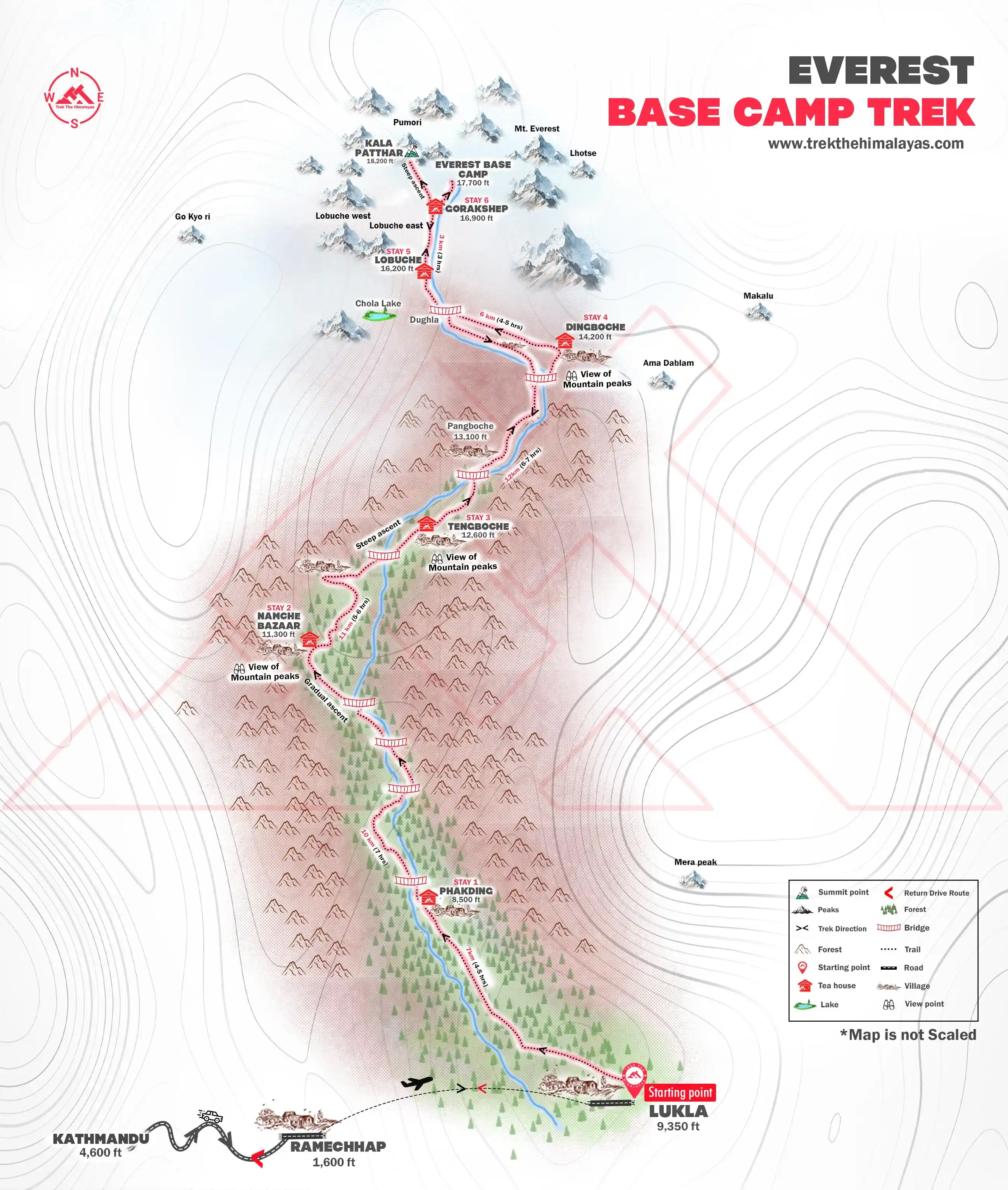
- Pulse rate at rest must be in between (60 to 90 beats per minute).
- Blood Pressure Reading must be in between (DIASTOLIC 70 – 90, SYSTOLIC 100 - 140 mm Hg).
- Respiratory rate at rest must be in between (12 to 20 breaths per minute).
- Should not have Liver and kidney issues.
- Should not have Diabetes Mellitus, Bronchial Asthma, Heart problems, Hypertension, etc.
- No pacemaker implant.
- People with Sinus issues, Epilepsy please contact to trek coordinator before booking the trek.
- If your BMI is not normal, Please contact our Trek coordinator before Trek booking.
Medical & Disclaimer Form (Mandatory Documents) Click here to download Medical & Disclaimer Form
- Junior trekkers (below 15 years) should have a company of parents/guardians.
- Trekkers between 15 to 18 years can come solo with the disclaimer form signed by parent/guardian.
- Medical & Disclaimer Form (Mandatory Documents) Click here to download Medical & Disclaimer Form
Important Links
- Mandatory Documents to Bring on A Trek Click Here.
- How to pay Add-ons, Submit Medical Forms, and Dietary Preferences Click Here to watch Video
How To Reach
Pick-Up Information
- It is essential for everyone to arrive at Kathmandu (1:00 pm).
- Upon booking the trek, you are required to come to our hotel. Your trek coordinator will provide you with details such as the name of the Kathmandu hotel, its location, and the contact person's number.
Options to Reach Kathmandu
-
The best way is to fly to Kathmandu Tribhuvan International Airport, which receives airlines mostly from South-east Asia and Europe. A number of direct flights fly from Delhi, Mumbai, Kolkata, Bangalore and Varanasi to Kathmandu. Popular airlines that operate regularly are Jet Airways, Air India, IndiGo and Nepal Airlines.
-
Delhi to Kathmandu by train + bus
- Day 1: Take a train from Delhi to Gorakhpur. The Vaishali Express leaves Delhi at around 19:45 and arrives at Gorakhpur Junction at 09:10 next morning, or there's another train from New Delhi at 17:20 arriving Gorakhpur at 06:35 next morning. The fare is around Rs. 2440 (£35 or $54) in AC1, Rs. 1240 (£18 or $27) in AC2, Rs. 785 (£12 or $18) in AC3 or Rs. 315 in Sleeper Class - check current times and fares at www.indianrail.gov.in or www.irctc.co.in.
- Day 2: Take a bus or jeep from Gorakhpur to the Nepalese frontier at Sunauli (Indian side) and Bhairawa (Nepalese side, often also called Sunauli). Journey time about 3 hours, Rs. 55 (£1 or $2).
3. Walk across the frontier, it's then a few minutes’ walk to the Bhairawa bus station. Take a bus or jeep on to Kathmandu. Buses take 9 to 12 hours, cost about 120 Nepalese Rupees or 230 Indian Rupees (£1 or $2). There are many buses daily, either daytime buses leaving regularly until about 11:00 or overnight buses leaving regularly from about 16:00 until 19:00. Indian rupees may be accepted here in Bhairawa, but not further into Nepal.
4. It's also possible to travel via Varanasi An overnight train links Delhi & Varanasi. Buses link Varanasi with the Nepalese border.
Drop-Off Information
- For your return journey from Kathmandu, you have the flexibility to choose between road or air transport options. Please note that our services extend only to the hotel, and the standard hotel check-out time is 11:00 am.
.webp)
Cost Terms
Inclusion
1. Accommodation (as per the itinerary):
- Day 1 and Day 13 Hotel Accommodation in 3 Star Hotel in Kathmandu with Bed & Breakfast.
- Day 2 to Day 12 Accommodation in Teahouse.
2. Meals (Veg + Egg):
- All meals Lukla to Lukla from Day 2 Lunch to Day 13 Breakfast
- Fresh fruit after dinner every day.
3. Support:
- 1 Versatile base camp manager handles communication and deploys extra manpower in emergencies.
- 1 Mountaineering & First aid qualified professional trek Leader.
- Local experienced guides (Number of guides depending on the group size).
- Enough support staff.
4. Trek equipment:
- Sleeping bag.
- Gaiters & Microspikes (if required).
5. First aid:
- Medical kit, Stretcher, Oxygen cylinder, Blood pressure monitor, Oximeter, Stethoscope.
6. Transportation (as per the itinerary):
- Arrival Departure Airport Transfer as per itinerary.
- Domestic airport transfers for Lukla.
- Kathmandu to Ramecchap /Lukla, and back.
7. Cloakroom facility available at the base camp for additional luggage.
8. All necessary permits and entry fees, up to the amount charged for Indian.
9. Services from Kathmandu to Kathmandu.
10. TIMS card.
11. EBC Map.
12. Farewell Dinner in Kathmandu.
13. Trek Completion Certificate
14. Complementary Trekking Kit Bag (Duffle bag if opted for Porter facility).
Exclusion
1. Insurance (Mandatory).
1. Food during the transit.
2. Any kind of personal expenses.
3. Mule or porter to carry personal luggage.
4. Emergency evacuation,hospitalization charge, etc.
5. Anything not specifically mentioned under the head Inclusion.
7.Extra Expenses.
- Porters for the personal bag*.
- Wifi, charging batteries, and hot showers.
- Customary gratuities for guides & porters.
8. Nepal entry visa (approximately USD 40, Bring Two Passport Size photos) only for foreigners
(Not for
Indians).
9. Unforeseen costs due to flight cancellation, weather conditions,
etc.
10. Extra night accommodation in Kathmandu.
Things can be provided on demand and availability (participant has to pay extra for these things).
1- Satellite phone/set phone - a type of mobile phone that connects via radio links via satellites orbiting the Earth instead of terrestrial cell sites like cell phones. Therefore, they can operate in most geographic locations on the Earth's surface.
2- Gamow/PAC HAPO Bag (Portable Hyperbaric Bag) - is a unique, portable hyperbaric chamber for the treatment of acute mountain sickness (AMS), also known as altitude sickness.
3- AEDs (Automated External Defibrillators) - are portable life-saving devices designed to treat people experiencing sudden cardiac arrest, a medical condition in which the heart stops beating suddenly and unexpectedly.
Cancellation Terms
Cancellations prior to 25 days from the start of the Trip
Refund Options
- 5% deduction of trek fee
- 100% cash voucher for any trip till one year
- Transfer your trek (any trek, any date) to your friend
Cancellation between 24 days and 15 days to the start of the Trip
Refund Options
- 30% deduction of trek fee
- 100% cash voucher for same trip till one year
- 85% cash voucher for any trip till one year
- Transfer your trek (same trek, any date) to your friend
Cancellation between 14 days and 10 days to the start of the Trip
Refund Options
- 50% deduction of trek fee
- 80% cash voucher for same trip till one year
- 70% cash voucher for any trip till one year
- Book the same trek, in the same season, with any other batch
- Transfer your trek (same trek, any date) to your friend
Cancellation less than 9 days to the start of the trek.
Refund Options
- No cash refund
- 20% cash voucher for the same trip till one year
- 10% cash voucher for any trip till one year
- Transfer your trek (same trek, same date) to your friend
Note- If a booking is made using a voucher or discount code, the policies related to vouchers and discounts cannot be modified.
In the unlikely event that TTH cancels a trek prior to the scheduled departure date:
While it is extremely rare for TTH to cancel a trek, we understand that unforeseen circumstances or natural disasters may occasionally require us to do so before the scheduled departure. These circumstances could include continuous rain or snow, thunderstorms, snowstorms, landslides, floods, earthquakes, or any other natural calamity that poses a risk to the safety of our trekkers. Additionally, unforeseeable events such as local riots, curfews, pandemics, lockdowns, government orders, or any similar situations that compromise the safety of the trekking experience may also necessitate a cancellation.
In the event of such a cancellation, TTH will provide you with a voucher equivalent to the amount you paid for the trek. This voucher can be redeemed for any of our treks within the next year, allowing you to still enjoy an adventure with us at a later date.
Note
-
The issuance of a voucher is not applicable in situations where you are required to descend from the trek for any reason. The trek leader may make the decision to send you down from the trek due to factors such as insufficient fitness level, symptoms of Acute Mountain Sickness (AMS), high blood pressure, exceeding the designated turn-around-time, health concerns, or if you are found smoking, drinking, or violating the rules set for the trek. In such cases, the provision of a voucher does not apply.
In the Rare Event that TTH Shifts a Trek
We would like to emphasize that weather conditions in high-altitude areas are highly unpredictable and can undergo sudden changes at any time, irrespective of the day. Additionally, circumstances beyond our control, such as natural disasters, political unrest, pandemics, and lockdowns, may impact the feasibility of conducting a trek. In cases where we are unable to proceed with an event due to such circumstances that are beyond our direct control, we will make every effort to provide you with an alternative trek that is safer and more suitable.
In such situations, we will issue a voucher to offset the cost difference between the originally scheduled trek and the alternative trek. This voucher can be redeemed at any time within one year from the date of issue. Please note that a refund fee or reimbursement of the cost difference is not applicable in these cases.
Note:
- Change of trek batch is dependent on the availability of seats in the batch
- In case of transferring a trek to a friend, he/she should satisfy all the mandatory requirements put forward by TTH
- TTH holds the right to change/cancel the policies, without prior notice
- Cash refund is applicable only in case of bookings made without using any promotional offer code or vouchers
Cash Voucher Terms
- This is a non-transferable voucher
- The voucher cannot be merged with any other offer of Trek The Himalayas
- The voucher is valid for Trek booked directly with Trek The Himalayas in India
- To avail the voucher please use your register phone number or e-mail id
- All the other Terms of booking a trek with Trek The Himalayas are applicable to the voucher
- Trek The Himalayas holds rights to add/remove any of the Terms and Conditions without prior notice
Itineraries are based on information available at the time of planning and are subject to change. "Trek The Himalayas" reserves the right to change expedition dates, people or itineraries as conditions warrant. If a trip must be delayed or the itinerary changed due to bad weather, road conditions, transportation delays, government intervention, airline schedules, sickness, or other contingency for which TTH or its agents cannot make provision, the cost of delays and/or other changes are the responsibility of the participant. TTH reserves the right to decline, or accept, any individual as a trip member for any reason whatsoever.
Trek Essentials
PDF Of Trek Essential Download
| Backpack with rain cover | (50 - 60 ltr) with comfortable shoulder straps |
| Day pack with rain cover | 20 - 30 ltr (If off-load opted) |
| Walking stick | Advisable (At least one) |
| Water Bottle / Hydration pack | 2 bottles of one liter each, People who use hydration pack 1 hydration pack and 1 bottle of one liter, Carry at least one thermos flask. |
| Small size tiffin/lunch box | 1 Nos |
| Snacks | Energy bars, dry fruits, electral/ors |
| Personal Medical Kit | Consult your doctor |
| T-Shirt (Synthetic quick dry) | 2 Full & 2 Half sleeves |
| Fleece T-shirt | 2 Nos |
| Wind stopper / Fleece jacket | 1 Nos |
| Windproof Jacket | 1 Nos. |
| Down feather / Hollow jacket | 1 Nos. |
| Thermal inner (Upper and Lower) | 1 Pair |
| Trek Pant (Synthetic quick dry) | 3 Nos. |
| Wind stopper / Fleece Pant | 1 Nos. |
| Waterproof gloves | 1 Pair |
| Fleece / woollen gloves | 1 Pair |
| Poncho / waterproof Jacket and pant | 1 Nos. |
| Sunscreen | 1 Nos. |
| Moisturiser | 1 Nos. |
| Chap-stick / Lip balm | 1 Nos. |
| Toothbrush and toothpaste | 1 Nos. |
| Toilet paper & Wipes | 1 Nos. |
| Soap / hand sanitizers | 1 Nos. |
| Antibacterial powder | 1 Nos. |
| Quick dry towel | 1 Nos. |
| Head torch | 1 Nos. (Avoid Hand torch) |
| Sun Cap | 1 Nos. |
| Woolen cap | 1 Nos. |
| Balaclava | 1 Nos. |
| Buff / Neck-gaiters | 1 Synthetic & 1 Woollen |
| Sunglasses | UV with dark side cover, People who wear spectacles - (A)- Use contact lenses | (B)- Photo chromatic glasses |
| Trekking shoes | 1 Pair (Waterproof, high ankle, good grip) |
| Floaters / flip-flops | 1 Pair |
| Cotton socks | 8 pairs |
| Woollen socks | 3 pairs |
| Gaiters | 1 Pair (TTH provides when required) |
| Micro spikes | 1 Pair (TTH provides when required) |
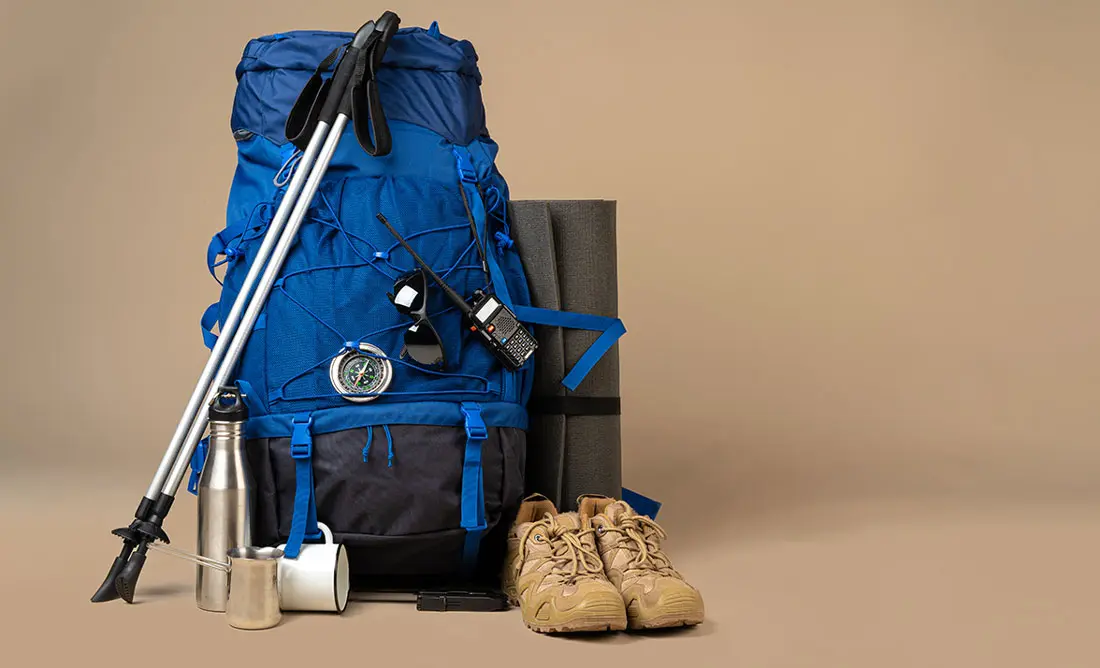
Frequently Asked Questions(FAQ)
To register with TTH, visit our website - www.trekthehimalayas.com and create your account. To create your account you will need to use your email address and fill in all the details, set your unique password and your account is ready to use.
- To book a trek with TTH, you first need to register with us and create an account.
- Choose the trek that you want to do and click on available dates.
- You will land at the login page, fill in the required details.
- Add Participants, choose add-on services click on the Pay now button, choose your preferred payment method, and make the payment. TTH accepts multiple payment options, including credit/debit cards, net banking, and UPI.
- You will receive a confirmation email from TTH with all the necessary details about the trek, including the meeting point, transportation, accommodation, and other important instructions.
- Click Here to watch Video
please send an email to us at info@trekthehimalayas.com or reach out to the numbers provided in the Help and Support section of your Trek Page. We will ensure that your issue is promptly resolved.
To book services such as off-load luggage and transportation, you can find them listed as add-ons. These additional services can be booked at the time of your initial booking. If you miss booking add-ons during the initial reservation, you can log in anytime and easily book 4 days before the departure date add-ons through the platform.
In such a situation, please log in to your account and transfer your trek or date to the desired one within 12 hours or drop us an email at info@trekthehimalayas.com 10 days before the departure date of the trek. After the initial 12-hour period, any changes will be processed according to the cancellation policy.
We recommend visiting our "Suggest Me a Trek" page. By filling out the form, our experts will contact you with the best possible trek options based on your preferences and experience level. Alternatively, you can reach out to us via email at info@trekthehimalayas.com or give us a call using the numbers provided on our website for personalized assistance and recommendations.
Family treks differ from regular treks by focusing on ease of difficulty, offering shorter durations for younger participants, Kid-friendly and easily digestible foods, child-friendly activities, maintaining a higher guide ratio for diverse age groups, and implementing additional safety measures for families.
Family Trek with Kids recommendation Only Dayara Bugyal and Chopta Chandrashila Trek.
Minimum age for TTH treks is typically 7 years, though this may vary depending on the specific trek.
Yes, you can take a kids to a high-altitude trek with a parent. Discuss with a trek expert before booking a trek.
- Junior trekkers (below 15 years) should have a company of parents/guardians.
- Trekkers between 15 to 18 years can come solo with the disclaimer form signed by parent/guardian.
- Medical & Disclaimer Form (Mandatory Documents) Click here to download medical and disclaimer form
Physical Fitness: Ensure your child is physically fit. Engage them in regular exercise, outdoor activities, and hikes to build stamina and endurance. Hydration: Emphasize the importance of staying hydrated at high altitudes. Encourage your child to drink water regularly, even if they don't feel thirsty. Proper Nutrition: Provide a well-balanced diet with sufficient carbohydrates for energy and foods rich in iron to prevent altitude sickness. Adequate Sleep: Ensure your child gets enough sleep in the days leading up to the trek. Quality rest is crucial for altitude adaptation. Educate on Altitude Sickness: Teach your child about the symptoms of altitude sickness, such as headache, nausea, and dizziness. Encourage them to communicate any discomfort immediately. Appropriate Clothing and Gear: Dress your child in layers to adjust to changing temperatures. Ensure they have appropriate trekking gear, including sturdy footwear. Positive Mindset: Foster a positive mindset. Encourage your child, and let them know it's okay to take breaks when needed. Medical Check-Up: Schedule a medical check-up before the trek to ensure your child is fit for high-altitude activities. Consult with a healthcare professional about any potential health concerns.
TTH takes special care to provide wholesome and nutritious food for children on treks. Here are some of the foods that are typically served for children:
Breakfast: For breakfast, TTH serves a variety of options like porridge, cornflakes, bread, butter, jam, honey, boiled eggs, omelettes, and pancakes. Children can choose from these options to fuel themselves for the day's trek.
Lunch: For lunch, TTH serves lunch which includes rotis, vegetables, rice, dal, and salad. The rotis are usually made fresh on the trek and are a good source of carbohydrates. The dal and vegetables provide protein and other essential nutrients.
Snacks: TTH provides healthy snacks like fresh fruits, dry fruits, energy bars, cookies, and biscuits to keep the children energized throughout the day.
Dinner: For dinner, TTH serves a hot and wholesome meal which includes soup, rice, dal, vegetables, and a non-vegetarian dish (if requested in advance). Children can also choose from a variety of desserts like custard, jelly, and fruit salad.
Dietary requirements: If a child has any special dietary requirements, TTH can cater to those needs as well. For example, if a child is lactose intolerant or allergic to nuts, the kitchen staff can make arrangements to accommodate those requirements.
Choosing the right trek for a beginner can be a bit overwhelming as there are many factors to consider such as distance, elevation gain, terrain difficulty, weather, and time of year. Here are some tips that can help you choose the right trek for a beginner:
1. Determine fitness level: Assess the fitness level of the beginner to understand their physical capabilities. This will help you select a trek that is challenging but not too difficult.
2. Choose a well-traveled trail: A well-traveled trail will have more amenities such as signposts, water stations, and shelter. It is also safer as there will be other hikers on the trail.
3. Consider the length of the trek: For beginners, it is recommended to start with a shorter trek that can be completed in a day or two. This will help them get acclimatized to trekking and build their confidence.
4. Look for gradual elevation gain: Choose a trek with a gradual elevation gain rather than steep ascents. This will make the trek easier and more enjoyable.
5. Check the weather: Check the weather forecast before selecting a trek. Avoid treks during the monsoon season or winter when the trails can be slippery or dangerous.
6. Research the trail: Read about the trail to get an idea of the terrain, altitude, and difficulty level. This will help you select a trek that is suitable for the beginner.
7. Consult with an expert: If you are unsure about which trek to choose, consult our trek expert Mr. Nitin (+91 70600 59773) between 10 AM to 6 PM (Tuesday - Friday). Mr. Nitin will provide you valuable advice and guidance.
Overall, it is important to choose a trek that is enjoyable, challenging but not too difficult, and suitable for the beginner's fitness level and experience.
It is not recommended for a beginner to choose a difficult Himalayan trek. Trekking in the Himalayas can be physically and mentally challenging, especially if you are not used to the high altitude, steep slopes, and rugged terrain. Choosing a difficult trek without the proper experience, fitness level, and preparation can be dangerous and put you at risk of altitude sickness, injury, and other hazards.
If you are a beginner, it is recommended to start with an easier trek and gradually build up your skills and experience. This will help you understand the challenges of trekking in the Himalayas, and also prepare you physically and mentally for a more difficult trek in the future. It is also important to choose a trek that matches your fitness level, experience, and interest.
There is no specific age limit for a beginner trekker. However, it is important to consider your physical fitness, health condition, and personal interests before embarking on a trek. Trekking in the Himalayas can be physically and mentally demanding, and requires a certain level of physical fitness and endurance.
If you have any pre-existing medical conditions or are above a certain age, it is recommended to consult with a doctor before embarking on a trek. It is also important to listen to your body and take breaks as needed during the trek to prevent exhaustion or injury.
We recommend visiting our "Suggest Me a Trek" page. By filling out the form, our experts will contact you with the best possible trek options based on your preferences and experience level. Alternatively, you can reach out to us via email at info@trekthehimalayas.com or give us a call using the numbers provided on our website for personalized assistance and recommendations.
Yes, you can join the trek. We have fixed departure groups where you can simply book your trek and we will take care of curating a group.
Before you start the trek, it is recommended that you make all the necessary phone calls as during the trek you may or may not receive network coverage, once you come back to the Base Camp, you can reconnect with your family via phone once again. You can share your trek coordinator contact detail with your family members to get the latest updates about your trek batch.
At TTH, we provide wholesome and nutritious meals during the trek. The food is vegetarian and includes a variety of dishes such as rice, dal, vegetables, chapati, paratha, pasta, noodles, and soup. We also offer snacks such as biscuits, and salty, and dry fruits during the trek. Special dietary requirements such as vegan, gluten-free, or Jain food can also be arranged if informed in advance.
If you are allergic to some foods, you need to let us know in advance so that we can make arrangements accordingly.
TTH is a trekking company that prioritizes the safety of all its participants, including women trekkers. They have a comprehensive safety system in place, which includes a dedicated team of experienced and trained trek leaders and support staff who are equipped to handle emergency situations and provide first aid.
TTH also takes specific measures to ensure the safety and comfort of women trekkers. They have a separate tent accommodation for women trekkers, female trek leaders, and support staff. They also provide separate toilet facilities for women and encourage a safe and respectful environment for all trekkers.
Moreover, TTH has a strict policy against any kind of harassment and has a zero-tolerance policy towards such incidents. They have a designated Internal Complaints Committee (ICC) to investigate and address any complaints related to harassment or misconduct. Overall, TTH has a good reputation for safety and responsible trekking practices, and women can feel comfortable and safe while trekking with them.
In case you are the only women in the group, we provide a single sleeping arrangement. Also, during the trek, the trek leader will always remain by your side to provide optimum safety and reassurance.
You can reach out to the trek coordinator to inquire about the number of female trekkers and their respective states who have booked the trek. Please note that the trek coordinator cannot disclose personal details of any trekker. Once you've confirmed your booking, a WhatsApp Group will be created for all the trekkers in your batch. This allows you to connect with fellow trekkers before the trek begins.
While many of our treks are led by female trek leaders, however, it is not possible to know which trek leader is assigned to which group. But nonetheless, whether the trek leader is male or female you can be completely assured of your safety and security with us.
Yes, it is possible to trek with periods. However, it is important to take some extra precautions and preparations to ensure a comfortable and safe trekking experience. Here are some tips that can help you trek during your period:
1. Use menstrual hygiene products that you are comfortable with, such as tampons, pads, or menstrual cups. It is recommended to carry enough supplies for the entire duration of the trek.
2. Pack wet wipes, hand sanitizer, and plastic bags to dispose of used hygiene products.
3. Wear comfortable and breathable clothing that allows for easy movement and reduces friction. Avoid wearing tight or restrictive clothing that can cause discomfort.
4. Carry pain relief medication, such as ibuprofen or acetaminophen, in case of menstrual cramps.
5. Stay hydrated and maintain a balanced diet to support your energy levels and overall health.
6. Take breaks as needed and listen to your body. If you feel uncomfortable or experience any unusual symptoms, seek medical attention immediately. It is also recommended to consult with a doctor before going on a trek during your period, especially if you have a pre-existing medical condition or are taking medication.
By taking necessary precautions and being prepared, you can have a safe and comfortable trekking experience even during your period. We provide proper disposal facilities for sanitary pad disposal during the trek.
We offer three person tents with twin-sharing for optimum comfort. A woman trekker will share a tent with another woman trekker and if you are the only woman in the group, you will be given a single accommodation for your comfort and privacy.
Yes, we do provide gears on rent. You can book it using you TTH account directly.
Mountaineering qualified Experienced and first aid certified Trek Leader, First Aid Certify local guide, Cook, helpers and supporting staff.
People suffering from Bronchitis, Asthma, High blood pressure, Epilepsy (got faints), TB , Heart problem or on higher BMI side are strictly not allowed to go on any Himalayan trek. Apart from this if you had any medical history, please let us know.
No. Alcohol and smoking isn’t allowed while on trek. It is totally misconception that it will keep you warm. Your body need to acclimatize properly and for that eat properly and drink enough water; these things will keep you warm.
Toilet tents provide a convenient solution for answering nature's call in the great outdoors. Dry toilets, in particular, offer a highly sanitary approach. By digging a pit and utilizing mud and a shovel, you can easily cover up your waste. This method ensures cleanliness and hygiene while camping or exploring in the forest.
Remember to pack essential toiletries to complete your outdoor bathroom kit and maintain proper personal hygiene during your adventures. With these practices in place, you can enjoy nature while also respecting it.
Layer Up From Head To Toe
Eat Full Meals, never sleep empty stomach
You can keep warmee (if you’re more susceptible to cold).
Use sleeping bag in right way and don’t leave free space in sleeping bag.
For upper body
– Thermal layer
– T-shirt (full-sleeves)
– Fleece T-shirt (for extreme colds)
– Fleece layer
– Thick Jacket/Down Jacket
– Waterproof or Windproof layer (outermost layer, when it is snowing or raining)
- For Lower Body
– Thermal layer
– Hiking pants (normal) or Winter hiking pants
Based on how warm you feel you can skip any of the above layers. Your outer later should be windproof since it is windy at high altitude.
The idea behind layering is that the more insulation you have the less cold you feel, and instead of wearing a very thick jacket if you wear multiple layers, your body will be better insulated against the cold.
Yes, we provide micro spikes and gaiters, if required.
Mandatory documents: 2 xerox of ID having address (addhar card/driving license), 2 Passport size photographs, hard copy Medical form signed & sealed by doctor, disclaimer form sign by trekker and high altitude insurance.
No. We don’t but we can suggest you good hotel/Stay nearby pick up location.
Yes, trekker must carry 2 water bottles 1 litre each so they can refill it at campsite for drinking and keep themselves hydrate.
You should buy shoes which has these three features –Good grip, Ankle Support and additional water resistant layers. Generally, we advise Quechua Trek 100, MH 500 and MH 100.
No one is forced to go on. There is always enough staff to split the party according to need and regroup later at the camp. Most people have no trouble reaching the highest campsite. If some members decide not to climb the final distance they can wait for the climbers to come back down the same way or take a lateral path to the descent route.
Trek The Himalayas is the safest and most trusted trekking organization in India. Our deep expertise and commitment ensure that each trekker can fully immerse in the Himalayan beauty while experiencing a well-organized and memorable journey. We are proud to be recognized among the best trekking companies in India and have been awarded the PHD Samman Award two years consecutively for Best Adventure Tour Operator. Our founders, themselves are proficient mountaineers and belong to the hilly states of India. At TTH we follow all the safety protocols. Our Trek Leaders are expertly trained in First Aid and Acute Mountain Sickness (AMS) management. The extensive experience is a key factor in establishing us as the best trekking company in India.
Explore the best trekking companies in India and see what sets them apart.Yes, Trek The Himalayas (TTH) provides customized trekking packages, and premium trek packages, apart from fixed departures tailored to your preferences and needs. We understand that each trekker has unique interests, timeframes, and fitness levels, so we are happy to design a customized trek package that aligns with your goals. If you are seeking a specific experience, such as camping under the stars, a photography-focused trek, or an itinerary that includes cultural and heritage sites, our team can help create the ideal trekking package for you.
With a customized trek, you have the flexibility to choose aspects like trek difficulty, duration, group size, and even special add-ons like guided tours of nearby villages or extended camping nights at scenic locations.
Our customization options are ideal for families, groups, corporate teams, and solo adventurers looking for a tailored journey through the Himalayas.
Yes, you need special permits for Trekking in India, especially in protected or restricted areas. In states like Uttarakhand, Himachal Pradesh, and Ladakh, trekkers may need to obtain permits from local authorities or forest departments before starting their journey. For international trekkers, special permits like the Inner Line Permit (ILP) are required for regions such as Ladakh and Arunachal Pradesh. To make the process easier, Trek The Himalayas assist adventurers in obtaining all the necessary paperwork and permits, ensuring a hassle-free trekking experience.
Trek The Himalayas is committed to promoting Sustainable Tourism and Eco-Friendly Tourism by following responsible trekking practices and encouraging our trekkers to do the same.
We have introduced impactful initiatives like Heal Himalaya and Leave No Trace. Through these programs, we regularly organize cleaning drives along trekking routes and surrounding areas to keep the trails free from litter. Our team carries trash bags during every trek, ensuring that all waste collected from the slopes is brought back to the base and disposed of properly. We also take active steps to reduce plastic waste by completely avoiding the use of single-use plastics and encouraging our trekkers to do the same. Small changes like carrying reusable bottles and eco-friendly alternatives can make a big difference in protecting the environment.
By choosing to trek with us, you become a part of this movement toward responsible and sustainable trekking.
Yes, Trek the Himalayas provides trekking tours to well-known pilgrimage sites, including Kailash Mansarovar Yatra, Adi Kailash Yatra, Char Dham Yatra, and Panch Kedar.
The Everest Base Camp Trek is a popular trekking route in Nepal that leads to the base camp of the world’s highest peak, Mount Everest. It is located in the Khumbu region of Nepal, at an altitude of approximately 18,200 ft above sea level. The trek shows the stunning views of Mount Everest and surrounding peaks and also gives a wonderful opportunity for trekkers to experience the local Sherpa town and culture.
The trek to Everest Base Camp Trek usually takes about 13-14 days including acclimatization days. Trekkers start their adventure upon arriving in Kathmandu, then proceed through key destinations such as Lukla, Phakding, Namche Bazaar, Tengboche, Dingboche, Lobuche, Gorakshep, and finally Everest Base Camp, and Kala Patthar.
Lukla is one of the most adventurous and thrilling airports you will ever get to see. It is located at a high altitude with a very short runway. The further journey provides the beautiful experience of Sherpa culture, Namche Bazaar, food, and a glimpse of mountain peaks. In the high altitude, the area is rugged, but still in some parts, fertilization can be seen. There are monasteries where one can offer prayers and the Everest Memorial, dedicated to climbers who lost their lives during their ascent of Mount Everest.
The best time for the Everest Base Camp Trek is during Summer and Autumn. In these periods, the weather conditions are at their best and the views of the mountains are clear. And if we talk about specifically the best months to visit EBC are March, April, May, September, October, and November.
Trekkers are treated to the best sunrises over Everest in the early morning light. Along the way, they can explore vibrant local places like Namche Bazaar Sherpa town and monasteries. Namche Bazaar is a famous market for shopping, and you can collect souvenirs. During the trek, you will go through Sherpa towns and can experience the Sherpa culture, as well as the serene Tengboche Monastery, an important spiritual site with panoramic views of the surrounding peaks. The people of Sherpa culture are very helpful and are considered superhumans, as they are very acclimatized to that area and very well experienced in tackling any situation.
Although the difficulty level of Everest Base Camp Trek is not challenging while trekking, it's difficult due to high altitudes. With every new spot, the altitude rises and the chances of Acute Mountain Sickness (AMS) are very common. It is strictly guided to have a regular exercise routine before going to the EBC trek to ensure you're physically ready. Our Trek Leaders emphasize the importance of staying hydrated and provide continuous guidance to help you manage the altitude. With the right preparation and support, you can make the most of this incredible journey.
Our Leaders also guide trekkers to always inform them if they feel any uneasiness or discomfort during the trek. This proactive approach will help for early intervention to prevent minor issues from escalating. However, our trek leaders are highly trained and can often recognize signs of altitude sickness or fatigue through body language and symptoms before trekkers even mention them. They provide timely guidance to ensure a safe and enjoyable trek.
Some key points as trekkers, we should always be aware of and keep in mind for a healthy trek.
- Keep drinking plenty of water. It is important in preventing Acute Mountain Sickness (AMS) and its symptoms, such as headaches and nausea.
- Eat regularly. Consuming protein bars and other energy-rich snacks will help in keeping your energy levels up throughout the trek.
- Keep using moisturizers and lotions to prevent sunburn and keep your skin healthy in the harsh mountain environment.
Yes, trekkers are required to obtain permits for the Everest Base Camp Trek. However, when you trek with TTH, all the necessary permit arrangements are taken care of on your behalf. This means you can focus entirely on enjoying your journey without the hassle of paperwork. TTH ensures that everything is in order, so you can embark on your adventure worry-free.
While prior trekking experience is not mandatory, it is highly recommended. The trek involves long days of walking at high altitudes, so a good level of fitness and some trekking experience can be beneficial. It is important to prepare well with physical fitness and exercise before going on the EBC trek.
One can also follow the TTH fitness chart, which includes essential exercises specifically designed for high-altitude treks. The chart outlines the recommended exercises along with the optimal time and duration for each, allowing you to plan your fitness routine effectively. This structured approach ensures you’re well-prepared for the challenges of trekking at higher elevations.
Accommodations along the Everest Base Camp Trek are in teahouses or lodges, offering a unique and immersive experience. You'll be staying in some of the highest villages, and get a rare opportunity to witness the daily lives and customs of the local Sherpa communities. These lodgings not only offer a comfortable place to rest but also allow you to engage with the rich cultural traditions and lifestyles of people living in the remote corners of the Himalayas. Each stop along the route offers a chance to experience the warmth and hospitality of the mountain communities and adds a deeper dimension to your trekking adventure.
At higher altitudes, weather conditions can be highly variable and unpredictable. You should be prepared for cold temperatures, as well as the possibility of snow and rain.
The temperature at Everest Base Camp (EBC) varies significantly depending on the time of year. During the summer months, from March to May, temperatures at EBC are generally mild, ranging from 15-16°C during the day. However, nighttime temperatures can drop considerably, falling to around 0°C to -2°C, and sometimes even lower.
During the autumn months, from September to November, temperatures at EBC can plummet to around -7°C, and in some cases, they can be even colder. These lower temperatures can make the environment quite challenging, especially for those unprepared for the cold.
Given these temperature variations, trekkers must be well-prepared with appropriate warm clothing and gear. Layered clothing, including thermal base layers, insulated jackets, and high-quality gloves and hats, will help ensure comfort and protection against harsh conditions. Additionally, having proper sleeping gear and thermal liners will make nights at the base camp more bearable. Being prepared for these temperature extremes will enhance your trekking experience and help you enjoy more.
Preparation includes physical training, obtaining necessary permits, packing appropriate gear, and acclimatizing to high altitude.
Some essential points to keep in mind while preparing for the Everest Base Camp (EBC) trek:
- Warm Clothing: Layering is key. Pack thermal wear, insulated jackets, and warm layers to keep yourself comfortable in varying temperatures. A good base layer, fleece jackets, and a down jacket are recommended to manage the cold.
- Waterproof Jacket and Pants: A high-quality waterproof, and windproof jacket and pants will protect you from rain, snow, and strong winds.
- Permits: Obtain all necessary permits and documents. TTH typically handles these permits for you.
- Sturdy Trekking Boots: Go for well-fitting trekking boots with good ankle support. They should be waterproof and have a robust grip to handle rocky and uneven terrain.
- Sleeping Bag: Choose a sleeping bag rated for cold temperatures, with a temperature rating suitable for sub-zero conditions. This ensures you stay warm during chilly nights.
- Trekking Poles: Trekking poles help with balance and reduce strain on your knees, especially on steep or uneven trails. Adjustable, lightweight poles are best for this trek.
- Sunglasses, Sunscreen, and Lip Balm: Protect yourself from the high-altitude sun. Pack UV-protective sunglasses, high-SPF sunscreen, and moisturizing lip balm to prevent sunburn and chapped skin.
- Personal Medications and First Aid Kit: Bring any personal medications you may need, along with a basic first aid kit. This should include items for treating minor injuries, altitude sickness, and common ailments.
Altitude sickness is a risk on high-altitude treks. To minimize the risk, ascend gradually, stay hydrated, and allow time for acclimatization. If symptoms occur, it's important to update your trek leader and they will help you with the best guidance and might provide medical attention if needed.
Some essential points to keep in mind while preparing for the Everest Base Camp (EBC) Trek:
- 1. Physical Fitness: Ensure you are in good physical condition. Engage in regular cardio, strength training, and endurance exercises to prepare your body for the trek.
- 2. Acclimatization: Allow time for proper acclimatization to high altitudes to prevent Acute Mountain Sickness (AMS). Follow a gradual ascent plan and adhere to rest days.
- 3. Permits: Obtain all necessary permits and documents. TTH typically handles these permits for you.
- 4. Packing: Pack appropriate gear, including warm clothing, waterproof layers, sturdy trekking boots, a high-quality sleeping bag, and trekking poles.
- 5. Hydration and Nutrition: Stay hydrated and maintain a balanced diet. Carry energy-boosting snacks like protein bars and keep up with regular water intake.
- 6. Health and Safety: Inform your trek leader if you feel unwell at any point. Follow their advice and be aware of AMS symptoms.
- 7. Weather Conditions: Prepare for varying weather conditions. Even during favourable seasons, temperatures can drop significantly, especially at higher altitudes.
- 8. Carry Sufficient Cash: There are no ATMs in Lukla, so it’s crucial to bring enough cash for emergencies. Additionally, Kathmandu offers some of the best and most affordable options for purchasing trekking equipment, so ensure you have sufficient funds for both emergencies and any gear you may need.
The Top Nepal treks are Khopra Ridge, Annapurna Base Camp Trek & Mera Peak Expedition.
Yes, most teahouses offer charging facilities, but there may be a small fee for using them. Bring a power bank as a backup to ensure you have enough power for your devices.
While solo trekking is possible, it’s recommended to trek with a guide or as part of a group for safety reasons. Guides provide support, navigation, and help with local regulations and permits.
The total Everest Base Camp Trek distance is around 112 kilometers. The journey begins by arriving in Kathmandu, followed by a small flight to Lukla. The trekking trail to EBC begins from Lukla and passes through key destinations like Phakding, Namche Bazaar, Tengboche, Dingboche, Laboche, Gorakshep, and finally Everest Base Camp, then Kala Patthar.
The trekkers get to walk in the shadow of the tallest mountain and enjoy majestic views during the trek.
The Everest Base Camp Altitude is 17,700 ft. although the maximum elevation during the EBC trek is 18,200 ft. Reaching at this high altitude is no small thing and requires careful acclimatization, physical fitness, and mental endurance since the oxygen level is low and the temperature is severely cold.
The Everest Base Camp Trek Cost is 67,000 INR per person. The Everest Base Camp Trekking Package of TTH includes accommodations, meals, trek equipment, First Aid, and support staff including local experienced guides, base camp manager, and professional trek leader.
Yes, The Everest Base Camp Trek Itinerary can be customized to fit your preferences. Trek The Himalayas offers the option of customized treks, where you can plan your journey just the way you want. These special batches come with top-notch facilities, premium-quality stays, and meals prepared to match your tastes. The daily itinerary is also designed according to your pace and requirements. You can even customize a trek exclusively for your group!
For more details about customized treks, click here
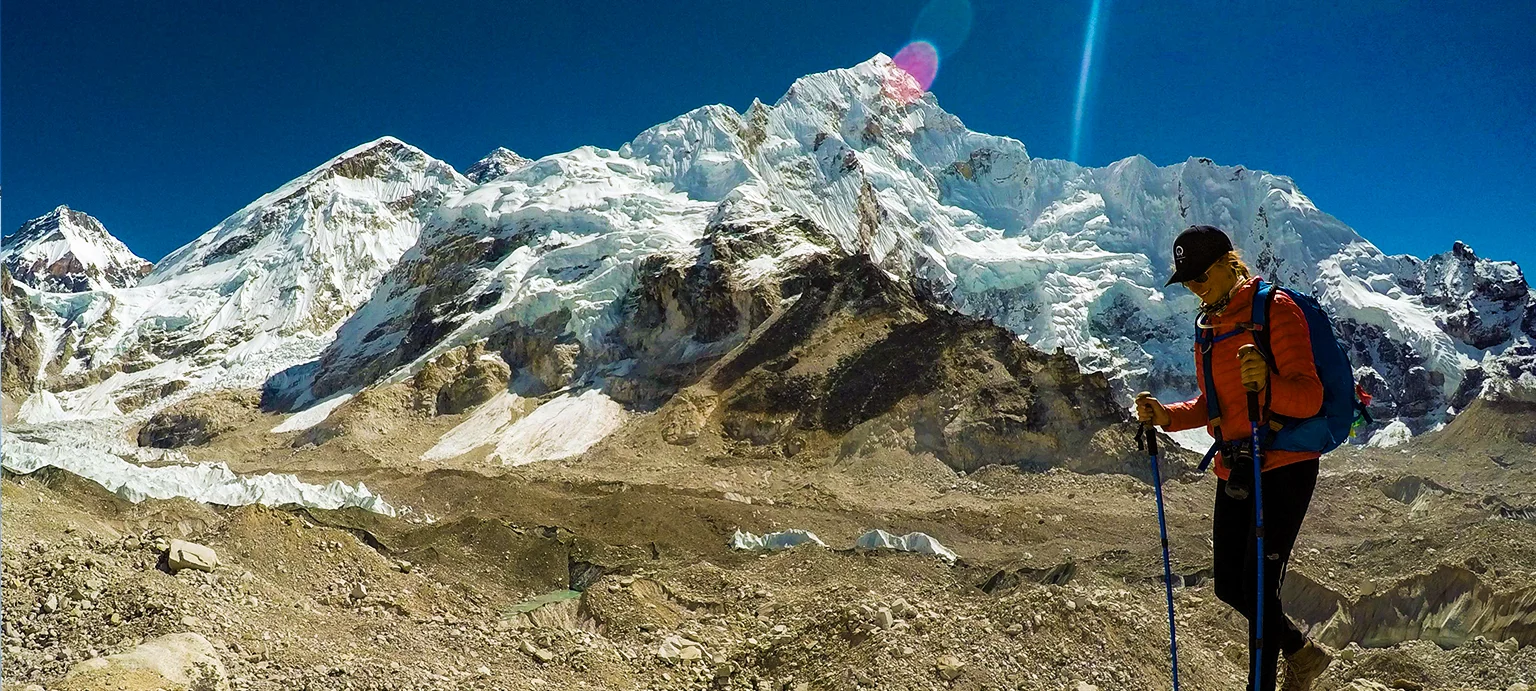
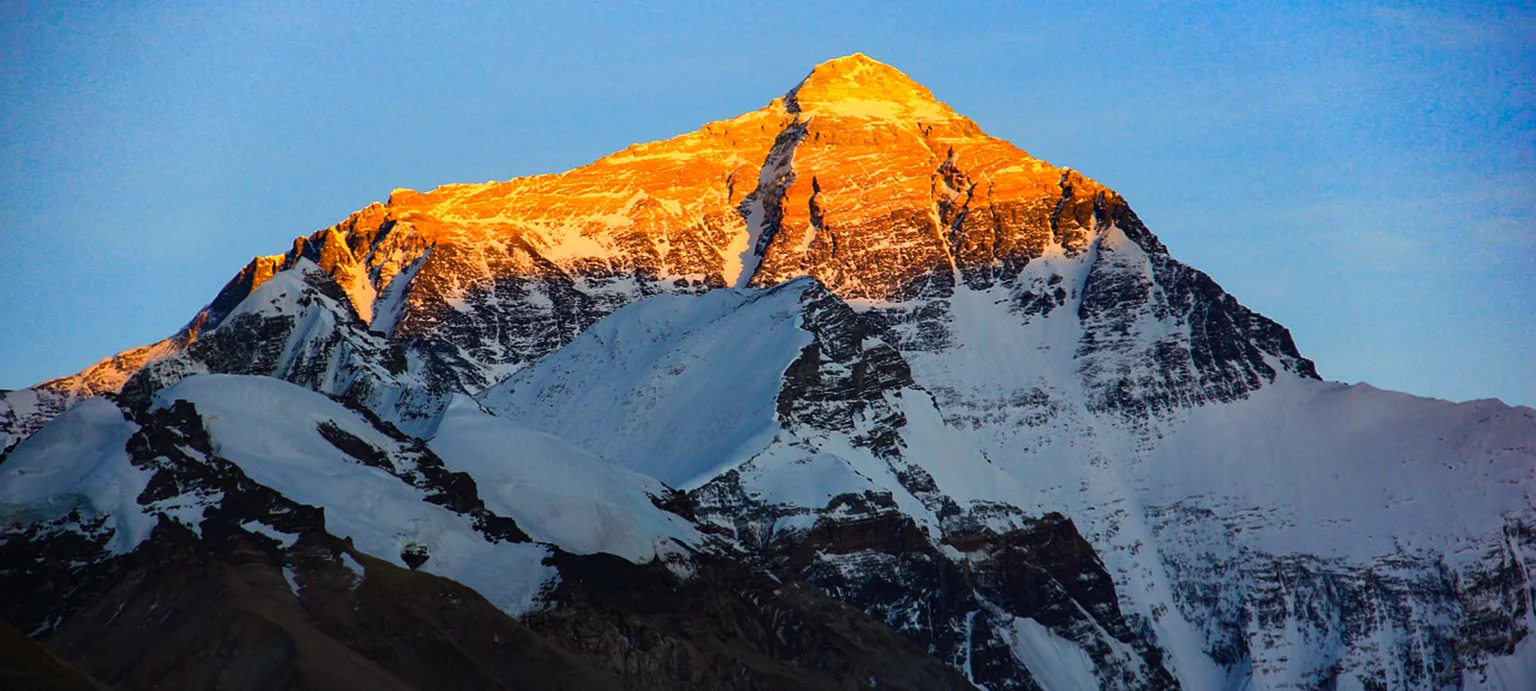
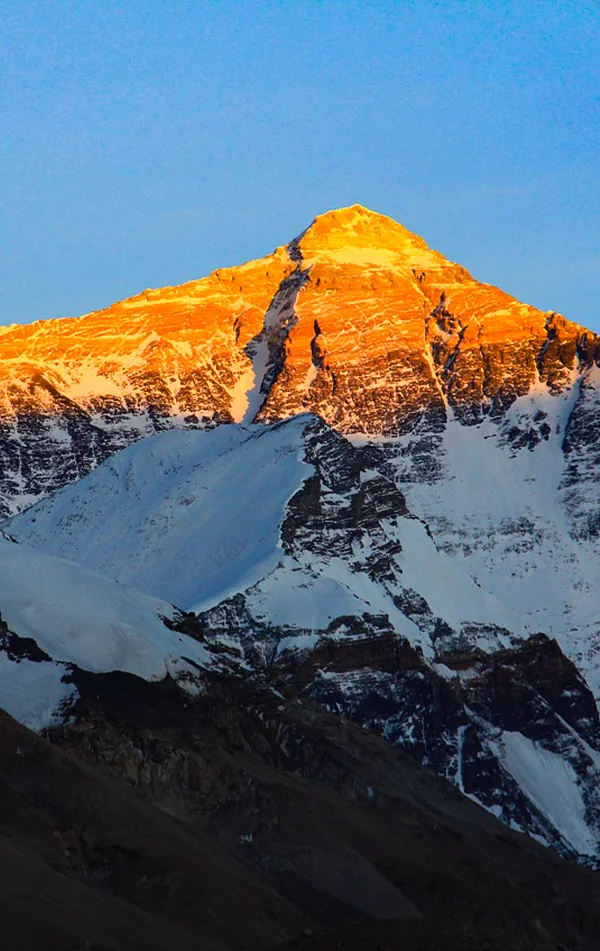
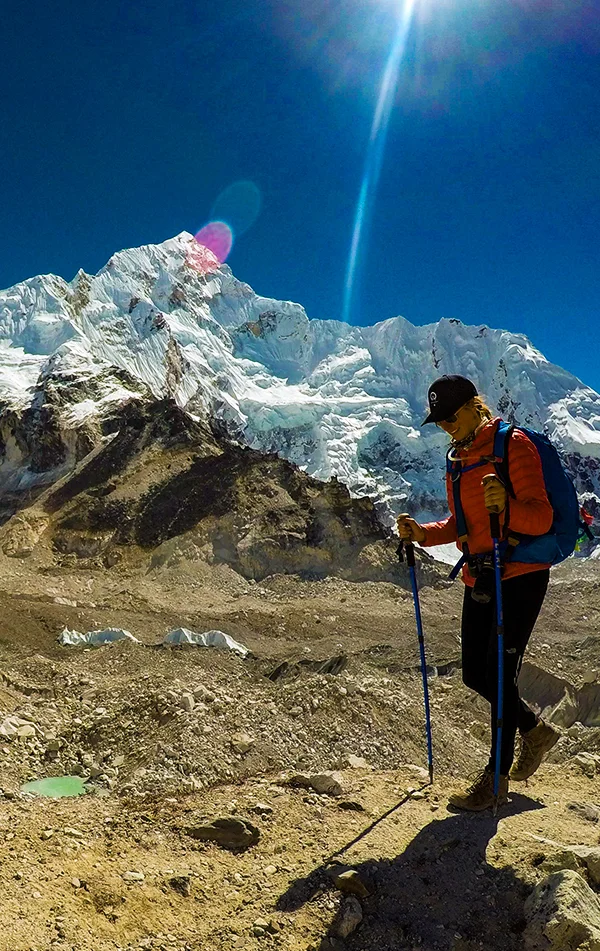
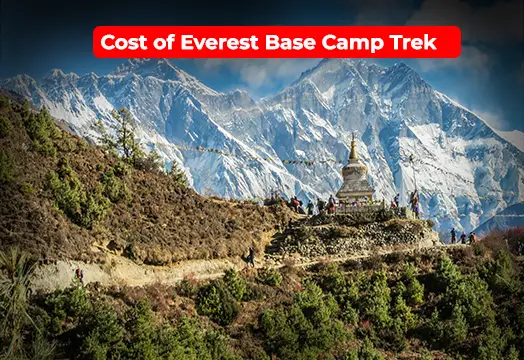
.webp)
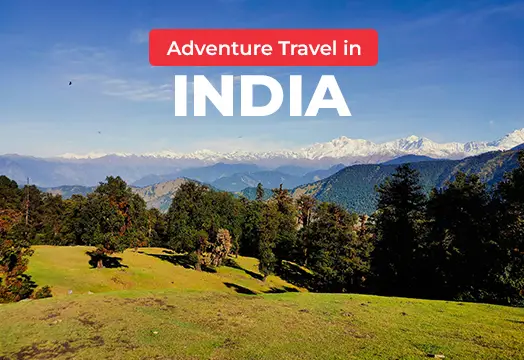
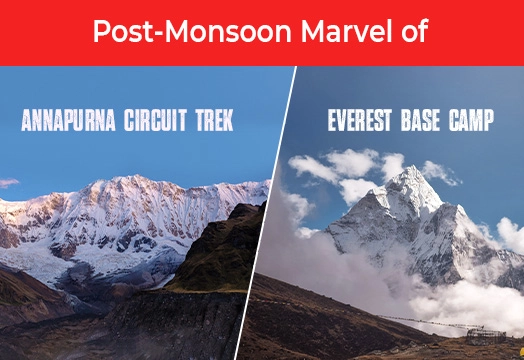
 (2) (1).webp)
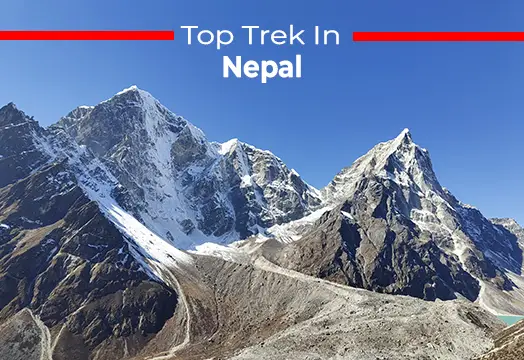

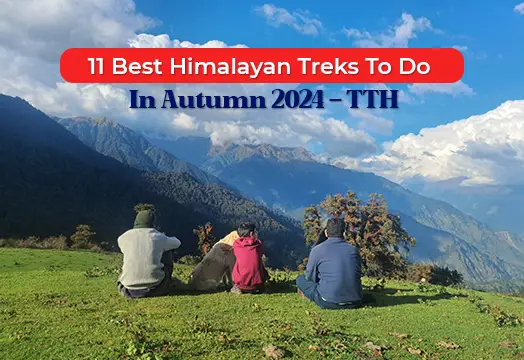
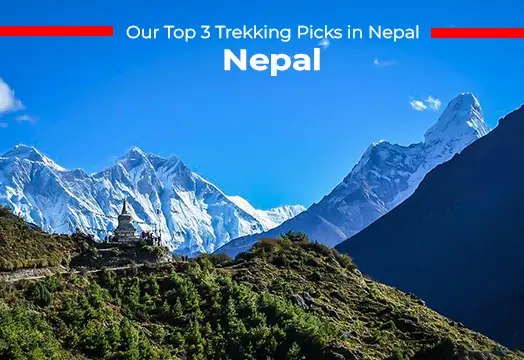
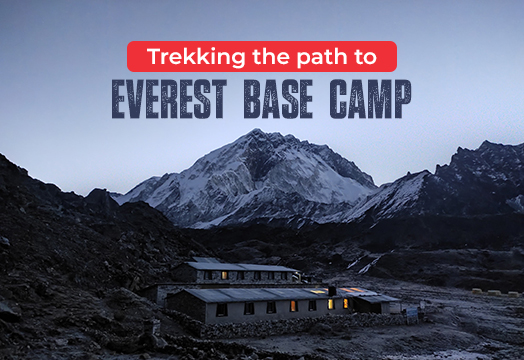
.webp)
